The New Bridgeporters: Men of Maplewood and Growth of a Community
By Abraham Lima
This is Part 3 of a 5 Part Series at the Bridgeport History Center:
To read the previous articles, use the guide below to navigate.
- Part 1 “En El Principio, Los Mojados en USA” and “What are Tortillas?” https://bportlibrary.org/hc/hispanic-populations-and-culture/when-the-aztec-eagle-began-her-soar-over-bridgeport-part-1/
- Part 2 – “From Puebla York, Oaxakeepsie, and Mexchester” https://bportlibrary.org/hc/business-and-commerce/when-the-aztec-eagle-began-to-soar-over-bridgeport-part-2-from-puebla-york-oaxakeepsie-and-mexchester-2/
The New Bridgeporters: Men of Maplewood and Growth of a Community
| “In reality, I don’t know about the origins of the [Mexican] population is in Bridgeport. I only remember in the year 1988 when I arrived in the country and precisely arrived in Bridgeport, the population was very small…I can’t give you a stat, maybe 400 or less, the majority mostly men, and in the 90s, the population grew considerably, there started to be [Mexican] women and later children [in Bridgeport]. The great majority at the time were from Puebla and Oaxaca. Today [in Bridgeport] we find [people] from Guerrero, Michoacan, Veracruz, and other states….
The people from Zaachila first came to Poughkeepsie. They say that the owner of the Athena Diner traveled to Poughkeepsie to visit his family who also had or owned a diner and he was surprised by the way the workers did their work and he asked his relative to get him people to bring to work at his restaurant and he agreed and I don’t know if he gave him some of his workers or looked for workers for him and he brought them himself. Apparently, they lived in the restaurant. Then they got them an apartment in Bridgeport and sent them a taxi to pick them up and return them after they had completed their work schedule. The people he brought were like 4 and from there those 4 brought more and in 1988 when I arrived we were only like 15 people from Zaachila and I came because my father was working here too.” – Miguel Angel Mendoza, who arrived in 1988 from Villa de Zaachila, Oaxaca, Mexico to Bridgeport, Connecticut. Today a painter in New Haven. To learn more, read the previous article “When the Aztec Eagle began to Soar over Bridgeport; Part 2,”). |
This Article’s Table of Contents:
- The Arrival of Mexicans in Hispanic Bridgeport
- From San Bernabe to Black Rock
- La Trinidad Tepango’s Tamale-Man Starts the 1st Mexican Business
- Mexican Bridgeport in the early ‘90s: The Men of Maplewood
- La Poblanita’s Sequal: La Flor de Mexico Bakery
- Building a Home in “San Pedro”
- “El Mexicanito” Grocery and Garibaldi Restaurant: Zaachila on Park Ave
- The School Life of Mexican-American Experience
- Guerrerenses and Indigenous Languages in Bridgeport:
- Tapatio and Tequila: Jalisco and Michoacan
- From Tlaxcala and New Haven
- Guelaguetza Grocery
- The Pizzamen of Puebla and Ovenmen of Oaxaca
- San Bernabe, Santa Martha, and Santa Clara
- San Luis Tehuiloyucan Tries Connecticut
- The Trades Diversify: From Diner Dishwashers to Light Industry Laborers
- Mexican Black Rock
- Bridgeport Mexicans Establish Statewide Association
- Mexicans Evangelizing Mexicans
- Mi Rancho Grocery: Mexican Black Rock Grows
In the 1990 census, which categorized Hispanics by national origin, the City of Bridgeport numbered 599 people of “Mexican origin” according to the census, and 193 people were numbered as being born in Mexico.
Bridgeport was second in Connecticut for people of Mexican origin. The Mexican population was 4th of all Hispanic groups, it was smaller in Bridgeport than the 3 Hispanic categories, the Puerto Ricans, and smaller numbers of Cubans and Colombians. In total, Bridgeport’s Hispanics numbered 35,840 people, mostly Puerto Ricans, smaller numbers of Cubans and Colombians, and a smaller minority from the rest of Central and South America. The 1990 census counted Stamford has the largest Mexican-origin population in Connecticut, at 912 Mexicans out of 9,846 Hispanics. New Haven’s count was 781 Mexicans, and Norwalk had 182.
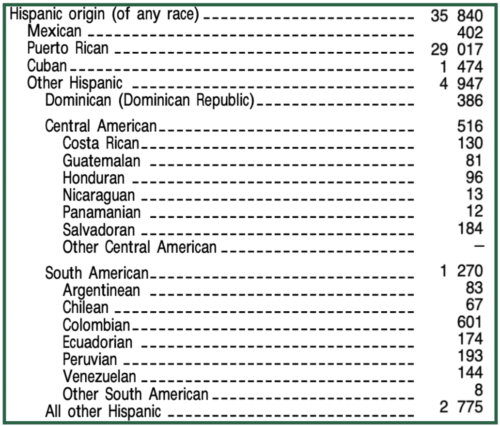
Asking other Hispanics from groups already in Bridgeport when Mexicans began to arrive, a Puerto Rican who arrived in Bridgeport in 1989, Ramon Jimenez, a children’s therapist, recalls that when he arrived “There weren’t as many [Mexicans] as there are now. There were some, but not as many”. He said, “They came from New York”. The neighborhoods Mexicans were mainly in were “the East Side and uh, what’s that neighborhood called, the Hollow…. A lot of them work in restaurants… but a lot of them are pizza guys too”.
Also on the topic, Juan, a Colombian who arrived in Brooklyn at age 5 in the 1970s and graduated from Bridgeport’s Central High School in 1983, recalled his experience working with Mexicans in the early 1990s. “Mexicans came later in life. As far as now, if you wanna learn something if you go to Darien and you see a stone wall, you see the gravel marks, the gravel marks from the Irish, they’re real thick, they’re wide. The next group of main immigrants that came in are Portuguese, they’re thinner. You go see a Mexican wall, there is no gravel-, they work the rock so precise.
That’s how you can see a mason’s history. So you go to a stone wall, you look at it, you see the cement gravel this wide, there Irish. Then the Portuguese came and made it thinner. Then when you get the Mexicans… they work the rock. It’s closer. That’s what I learned. So I was blessed learning [from Mexicans]… I was blessed with Mexicans. When we were working we were doing foundation work. It’s hard as hell because those things are heavy. So this Mexican kid comes in and he’s carrying two more. And I said “Listen, you could only do that for another 4 hours. He’s not gonna pay you more than he’s paying me. Don’t kill yourself.” Because you have to understand he’s making- so the Mexican came with that “oh I gotta work now, I gotta work now” …and I told him, I was like “dude, relax” he’s not gonna pay you more, and in four hours you’re dead and then I’ll be carrying one floor… so immigrants are weird. Some immigrants abuse immigrants, some immigrants help immigrants.
From San Bernabe to Black Rock:
Gregorio recalled “I came in 1990” from his town to Black Rock. He is from San Bernabe Temoxtitla, a village part of Ocoyucan Municipality, Puebla.
In the Mexican 1980 census, San Bernabe Temoxtitla had a population of 1,985 people. Of the town’s 314 homes, 114 had “floors other than dirt floors”, 233 had electricity, 11 had cars, 6 had refrigerators, 5 had running water, and 0 had telephones.
Gregorio said he had in Bridgeport a “cousin. They already had about 5 years here… they were here [in Bridgeport]the whole time… my cousin was here”
His cousin “She was from Cosioctla, but her husband was from San Diego” [Acapulco].
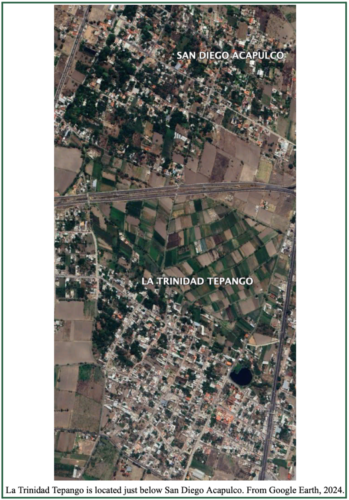
San Diego Acapulco is a small village in Atlixco Valley, bordering La Trinidad Tepango.
A community of people from La Trinidad Tepango had settled in the city, working in diners, as seen in the last article of “When the Aztec Eagle Began Her Soar Over Bridgeport”.
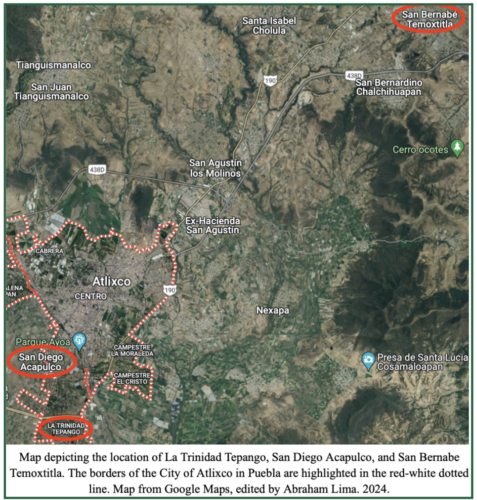
“One of my aunts and my mother told me that a cousin of mine had already come, and if I wanted to go to New York… Um, when they told me, they told me a lot about New York, but in truth, they were not in New York… We had to take the train from the airport to Bridgeport”
“I crossed the first of the first month of that year, 1990…I was crossing that day… in San Diego, in Tijuana. I arrived on New Year’s. That cousin of mine, we helped each other. My wife also came around March.”
Her daughter recalled “My father came first in 1990, and I came in 1992”.. his family because his cousins brought him specifically here [to Bridgeport].”
Why her father’s cousins settled in Bridgeport, she said “I have no clue. I never asked him. I don’t know how they started but I know it was only like 3 cousins, and then they brought him [her father] in, and then my father brought my mom, my mom brought my aunt and an uncle, and that’s it, and I guess everybody else started hopping the trolley [from San Bernabe Temoxtitla to Bridgeport]. I have no clue.”
Don Gregorio, his daughter, the rest of the family, and his cousins all lived at a 3-story brick tenement home on Fairfield Avenue near the corner of Alfred St.
Her aunt, Carolina, who arrived in Bridgeport in 1996, said Gregorio is “My brother-in-law [who]came in ’90 because his cousins who were from Atlixco were here… I believe that the one who was the first from San Bernabe was Don Gregorio, my brother-in-law. Washing dishes in Italian restaurants… in Bridgeport on Fairfield Avenue, in a restaurant called “The Castle”.
His cousins, Where in Atlixco were they from?
“From San Diego Acapulco de los Mangos”
San Diego Acapulco is the bordering community just north of La Trinidad Tepango. Carolina said “There’s a lot of people from La Trinidad Tepango as well” in Bridgeport.
Black Rock is split into two census tracts.
In 1990, the bottom section of Black Rock, which is between Princeton St and part of Ellsworth Ave, and Long Island Sound and Fairfield on the other, was 20% Irish, 12% Italian, 9.5% German, 9% Hungarian and 6.5% Puerto Rican. According to the census, there were also 36 Mexicans living in the census tract in 1990.
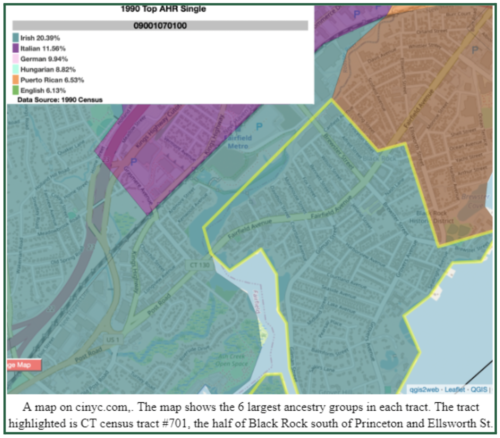
Gregorio and his family settled in this census tract, but bordering the other tract north of Ellsworth and Princeton St.
That census tract was 20.5% African American, 16% Puerto Rican, and 8.22% “Other West Indian” (West Indians in the census that were either not Jamaicans, Haitians, Trinidadians, Tobagonians, Virgin Islanders or were part one of those groups but weren’t specifically classified in the census), 6% Italian, 5% Hungarian and 5% “Other Hispanic or Latino”. There were 2,775 people in Bridgeport classified as “other Hispanic or Latino” in the 1990 census.
According to the census, 24 Mexicans were living in that census tract in 1990.
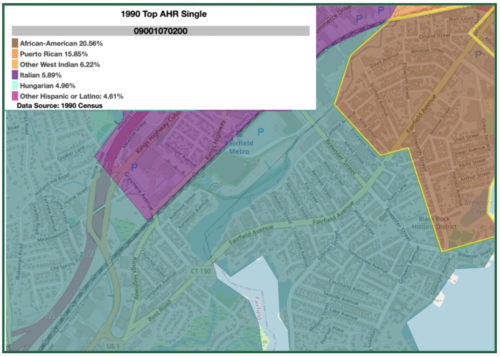
Did they work in restaurants?
“Uh [pause] no. They, they- yeah my father used to work for a restaurant here. A couple of blocks from here, it disappeared. It used to be Arizona Flats. He used to work there for years.”
She states that “Yeah a lot of people came from New York [to Bridgeport]. “I came from New York, New York, New York” and I’m like “Oh oh ok” because I came directly here. A lot of people came [from Mexico] directly here [to Bridgeport] too.”
Asking Juan when Mexicans began to arrive, he said “I think you guys [Mexicans] came to Bridgeport-” when a friend walked in. “Hey Smooth! Mexicans in Bridgeport? Early 80s right? When we had the first soccer team in the league they didn’t come at the beginning ‘cause remember it was all Spanish- Ecuadorian.”
In the early 1980s, a Hispanic team was formed by a mix of a few Ecuadorians, Colombians, and Argentinians in Bridgeport to compete with the city’s Portuguese, Italian, Polish, and other local ethnic teams. “To make that soccer team Spanish we had to mix it, Argentinian-Ecuadorian”. A few years later, as more of each arrived, there were teams for each of those nations and for Peruvians. “5 years later” after those teams, the Mexican (along with the Guatemalan) team joined the league. His friend replied, “It was mainly Jamaicans and Ecuadorians. Like back in the day.”
Juan went on “When they started, like, buying restaurants. Uh, 90s. 90s, 90s to Bridgeport! Yeah, Poblanita was the first. The only time you realize that there was a lot of Mexicans was probably in the 90s when they had their own soccer team and then they started having their restaurants. Yeah, that’s about right.”
Asked when he first met a Mexican “construction… I can’t give you a year… I’d say early 90s. They were uh, all illegal. Then what happened- it was real cool, because they liked the w- some foreigners abuse foreigners, I didn’t do that. So I enjoyed Mexicans, I liked the culture, I liked the food, I liked everything!”
In the year 1990, there were 0 Mexican-run restaurants or grocery stores in Bridgeport.
While New Rochelle’s first Mexican goods store, La Michoacana Grocery, opened in 1975, Port Chester had a Mexican grocery and a taqueria by 1985, and New Haven had El Charro Restaurant by 1991, Bridgeport lacked either a Mexican grocery or genuine Mexican eatery.
Asking Miguel Angel Mendoza, who arrived from Villa de Zaachila, Oaxaca to Bridgeport in 1988 “if there were any Mexican businesses or restaurants” he replied:
“I don’t remember the year they opened, it was in the 90s. When I arrived [in 1988] after a few years, the first Mexican restaurant that opened was La Poblanita and La Flor de Mexico bakery, then Mexicanito, and then later La Guelaguetza [Grocery] and Garibaldi.”
Mexican businesses opened in Bridgeport starting in the early 1990s, all clustering on one intersection.
La Trinidad Tepango’s Tamale-Man Starts the 1st Mexican Business
In the late 1980s and early 1990s, Rufino Flores’s uncle, Fernando Casiano, who lived in Queens, would come to visit his nephew and began to sell tamales to Mexicans he knew in Bridgeport. Fernando Casiano recalled that “from our auto, we sold [tamales]and we went house by house”
Rufino Flores said that his uncle “Fernando came with his little pot of tamales, he lived in New York. He would come to my house and ask me if there were any other Mexicans.” He would tell him, “Well there are no Mexicans here”. And I would take him and they would tell him” where other Mexican people they knew lived, and then those clients would tell him the same. “When I saw him, he had already sold here, he sold over there.”
By then, Fernando would tell Rufino, “What happened to “there are no Mexicans here”?”.
Runifo Flores said, “There I began to realize that there were Mexicans… people who came in the 60s that we didn’t know about. But they all came out for the tamales.”
Fernando Casiano, asked where he sold the tamales said “House to house… the entire city. Of course, where there were countrymen… it’s a lot of streets, I don’t even remember the names anymore. Where there were Mexicans”.
Asked how many Mexicans were in Bridgeport when he sold tamales as an estimate, Casiano said, “Put it at, some 500”.
“What were your first impressions of Bridgeport?”
Fernando replied: “Well, as I repeat, when we arrived there was not much of a Mexican community, well you know, we are used to seeing our people. Yes, there were Hispanic people, but more, more they were Puerto Rican, there were a few Central Americans, but few… as I understand that there, as I repeat, there on Wood Avenue, Maplewood, they [the few Central Americans] also lived there.”
Fernando Casiano said that at the time “I lived in New York… in Queens, so a relative lived here [Rufino Flores] and I started selling tamales, bringing them from there to here, and I saw that there were no Mexican businesses, we are talking about ’89 and ’90. And I encouraged my nephew to open a small business together there on Park Avenue”.
Why Park Avenue?
Casiano said, “because I saw that it was a concentration of… more so than anything, Hispanic.”
“Hispanics as in Mexicans?”
He replied “I think that there were not only Mexicans, of all nationalities, who were always seen there, in front of the market [then Waldbaum’s Supermarket], I was there – there was that opportunity, that little place, and we spoke to the owner and we got our little shop. We started working there.”
Rufino Flores recalled “There I waited for the bus [on the intersection of Park and Pequonnock where La Flor de Mexico Bakery is today.]While Rufino Flores waited for the bus “I saw that they put up a sign that said ‘for rent.’
The owner, Rufino Flores said, “he was a Chinese man, he already died now.” He showed him around. “The property: it had everything, its own kitchen…”. The man said, “If you want it, it’s $760”. I made $150 at the diner…
On Saturday when Fernando came, I told him, ‘They are renting a place on Park Ave. And he said, “Let’s go see it”…
Flores said, “We went to see a lawyer,” something Fernando had insisted.
The lawyer, a Puerto Rican, Flores said, “She had a friend who worked for the city… in the department of health… [the lawyer said]“I know someone from the city who doesn’t charge anything… She’s my friend.” And that’s where it all started.”
The city official’s name, Rufino Flores said, was “Rosa Correa”. She offered to help them set up, learn and pass through the health department inspection system, and anything related to government. Rosa Correa arrived in Bridgeport as a child in 1957 from Ponce in Puerto Rico. Described by the Connecticut Post as a Hispanic activist, she never held a political office but served on many boards and committees in Bridgeport throughout her life, according to The Post.
“I told Fernando I needed to go work at the diner” Fernando convinced him to leave his job at the diner and open a Mexican restaurant, “La Poblanita”.
The current owner of Frankie’s Diner, Nick Rousass, said when his father and 3 other men ran the diner, “Rufino Flores used to work here when I was a kid. He left to start La Poblanita… That was the first Mexican restaurant in Bridgeport”.
Antonio (Tony) is from La Trinidad Tepango as well and has worked at the diner since 1986. His wife, a Portuguese immigrant raised in Bridgeport, said “Rufino worked here for a long time, and I went to help him at La Poblanita too. Because before they opened there were no Mexican stores or anything. The closest thing to Mexicans was the Casa Grande. Because it sold Mexican products. But like now? Nothing, nothing! It was Mr. Fernando who was the first.”
Asked what Bridgeport’s Portuguese thought of the Mexicans at the time “I don’t know what they thought of them. My opinion was that they were good people, good workers, and well-mannered. Now, I can’t say for everything, but those I’ve met, I can’t say anything bad because they treated me with kindness.”
La Poblanita on Park Avenue (between the intersection of Beechwood Ave and Pequonnock St) opened around 1991 or ‘92 at 1666 Park Ave by 41-year-old Fernando Casiano and his nephew Rufino Flores, hailing from La Trinidad Tepango outside the city of Atlixco in the state of Puebla.
The term Poblano (for males) or Poblana (for females) is the demonym for someone from the state of Puebla, and the suffix -ita in Spanish is added to words to show endearment. La Poblanita translates to “the little woman from Puebla”.
The stretch of Park Avenue where the restaurant is marks the border between the Hollow neighborhood to the east and the West Side to the west.
La Poblanita was featured along with other Bridgeport restaurants in the 1995 cookbook “Adventures for Your Palette, a Foodies Guide to Bridgeport, Connecticut”, which was itself a subject in a 1997 New York Times article “New Takes on the Melting Pot”.
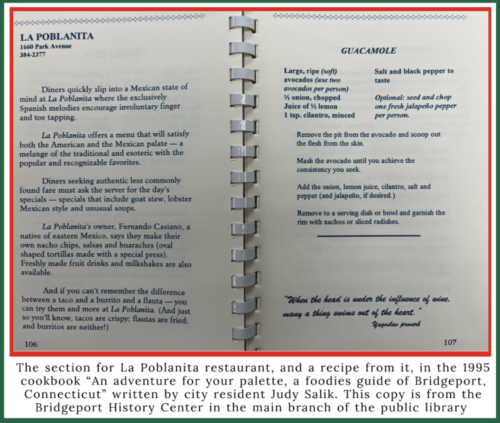
The biggest challenges in starting La Poblanita were a “lack of resources” but also that the line of work was new for them. “we had never worked in this trade before” as owners of a Mexican restaurant. He said the two would go to restaurants and look at how food was served and think “If they prepare it like that, why not us?”.
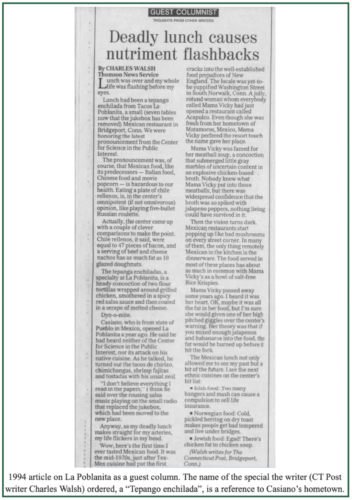
Tony recalled that the food at La Poblanita was “Yeah, pretty much the same. When they opened they sold tacos, tostadas, enchiladas… It was packed. All the time. La Poblanita? It was- It was packed.”
His wife said “It was the only Mexican restaurant. Americans came. They came from Westport. They came from Norwalk. A lot of people came. It was always packed.”
Tony continued, “from Fairfield. All that.”
However, most of the clientele “almost [everyone was]Mexican. Mhm.”
Casiano recalled that at the time, “at first, it was all men who lived over here. That’s why we had that opportunity because they didn’t – they had to go and look for somewhere to have dinner, somewhere to have breakfast. Since they were, then, there were only single people, they hadn’t brought their families yet. There were [families], but only two percent, one percent. They arrived, but more later.”
Alex Lima, then of Port Chester, recalled “Yes, that [La Poblanita] was the first one, and then La Flor de Mexico ‘. When asked how he knew despite not living in Bridgeport then, he responded “I went to Bridgeport from time to time. About… 1984-1985, I started working for the city of New Haven, and on the way back [to his home in Port Chester] we would go to Bridgeport to drink and we would go there to eat at that restaurant. Later, they brought in Mexican karaoke to sing and it became famous… people came from other places to eat there.”
Gregorio said, “There in Port Chester, there too are many from Atlxico. The whole cluster from Atlixco is there”.
Maria Carmona (father arrived in 1954 in Bridgeport and originally from Cholula, Puebla, read the last article for story) said that “My mom and dad considered La Poblanita the first [Mexican restaurant in the Bridgeport area].
The deal on Tex-Mex as I see it is that it was more recognizable (and less foreign) as a cuisine back then than many other types of Latin food because it had a US connection and was already somewhat familiar. Plenty of Americans operated Tex-Mex restaurants.
Locally, there was one in Stratford for years, and we hated it. Tex-Mex was nothing like the amazing Mexican food we knew. There was even a national chain called Chi Chi’s (no relation to the prepared food brand) and that was American-owned… and they [Carmona’s parents] always said La Poblanita was the first.”
Mexican Bridgeport in the early ‘90s:
Asked how many people from his village of La Trinidad Tepango lived in Bridgeport when he moved from Queens around 1991, Fernando Casiano said they were “Mmm, like about 20. Yes, they were already there for some good time before”.
Asked, “when you arrived, were there already Mexicans in Bridgeport?” Casiano said
“There were, but very select, very much- recognized where they were because it wasn’t like now. Now you go up North Avenue, you go up Park Avenue, you see Mexicans everywhere, and well, it’s large the community”
The majority of Mexicans were “When I arrived here the majority were from the state of Oaxaca. They were from the state of Oaxaca because I remember well everyone who helped us achieve all our dreams that we wanted to realize, well it was the entire Oaxacan community. Why? Because right away you could hear their accent, and they told us their stories.”
Asked what town in Oaxaca in particular were the Oaxacan in Bridgeport from, Casiano said, “At that time I knew that the Oaxacans were from Zaachila. Zaa-chi-la”.
Asked, “What were their stories?” Casiano said “Well, that they had arrived, like us, and to work. To work… They worked, or still work in restaurants, a bit in construction there were a few.”
The restaurants, Casiano said “They’re all open today. Colony Diner, Frankie’s, Andros Diner, Dutchess”.
From the towns in southwestern Puebla in Bridgeport, Fernando said: “There were very few… for them, New York is a blessed land, those from Acatlán, Tulcingo, Piaxtla… Tehuitzingo… Chinantla”. He recalled how when he was in New York all the taquerias and Mexican businesses were named after towns there.
“Did you meet any Mexicans that worked in the factories?” He responded “Well, I think so, …they just didn’t say that they worked. But yes, that there were, there were, but they didn’t tell us…
Casiano said “Typically, the famous street that I knew before was Maplewood. Those areas were very well known to the Mexican. That street there were three, four apartments, and everyone was just purely Mexican.”
When asked, “what part of Maplewood?” “Maplewood, there were some that were in Maplewood and I think Iranistan, but there in that area was the most, and others lived up over by East Main, but it was very minimal. Yes, everyone concentrated more on this area by Park Avenue ”
Maplewood Avenue passes through the West Side and West End of Bridgeport. It starts on Park Ave where The Hollow ends and West Side begins, and ends at Dewey St where Mountain Grove Cemetery is.
In the Connecticut death certificate records, a few young Mexican immigrants in Bridgeport were listed in the early 1990s.
Luis Estrada, born in 1968, was 22 years old and lived at 217 Beechwood Avenue in the West Side when he died in 1990. His occupation is listed as “gardener/landscaper”.
Luciano Hernandez was born in 1961, was 28 years old, and his address was listed as 136 Logan St in the East End when he died in 1991. His occupation was listed as a landscaper for a company called “Laflamme”.
Floriberto Hernandez-Jimenez was born in 1964, was 28 years old, and lived at 187 Center St in The Hollow neighborhood when he died in 1993. His occupation was listed as “laborer” and the industry he worked in as “restaurant”. The latter two’s education level was listed as “primary/secondary.” Estrada did not have his education level listed.
One street north from Center St, at 175 Catherine St in The Hollow, was where Juan Sosa lived. He was born in 1965, was 27 years old, and was listed as a “mechanic helper” working at an “auto shop” when he died in 1993.
Besides 136 Logan St, which is a warehouse, the other 3 men were put in as living in either The Hollow or the West Side area. All four men were listed as being born in “Mexico” and their “Hispanic origin” as “Mexican”. Where in Mexico they were from is not specified.
Asked about the education level of Mexican immigrants then, Fernando Casiano said, “On my part, I can tell you I didn’t study past primary school. Only 3rd grade… me, the third year of primary only.” Primary school in Mexico goes from first to sixth grade.
How did the Mexicans in Bridgeport get around when Casiano arrived, he said “Well, by bicycle, however you could. By foot, or taking the bus. We didn’t have cars, why should I say otherwise.”
There were already “some Poblanos” in Bridgeport then, “some from Tochimilco, Huejotzingo Santa Clara [Ocoyucan], among other towns in Puebla from where people in Bridgeport, that Fernando had encountered then, were from. These are rural towns in the central Puebla region surrounding Atlixco and Puebla City.
Don Gonzalez, a manager at a pizzeria in Bridgeport, arrived in Bridgeport in 1992 from Puebla.
Gonzales is not from Trinidad Tepango. “I am not from there, I am from San Matias Tlalancaleca… I haven’t met anyone from my area. The people, at least those I know, are from Atlixco. Atlixco and Oaxaca”.
He first settled in New York City. “I came to Bridgeport because someone from La Trinidad Tepango said there was a job here as a dishwasher. I came because I couldn’t find work in New York. And he told me “Do you want to go to Bridgeport? I have some nephews there in a restaurant that need a dishwasher.
When I came there were almost no Mexicans, there was only La Poblanita. La Flor de México with Don Rufino, before La Flor de Mexico was La Poblanita. Then they divided and expanded, La Poblanita went to one side and there La Flor de México was created.”
I have some cousins in Hartford. Now in Hartford, there are hardly any from my town, there are very few. But from San Felipe, oh there are many from San Felipe in Hartford. Again, like those from La Trinidad Tepango in Bridgeport. Nobody comes here by chance. It’s always because of a friend. If you’re in Mexico and your cousin is in Las Vegas, you’re going to go there. Or to Chicago, or Bridgeport.”
“They lived wherever there were apartments. They lived in crowded conditions. Wherever they could find a place to rent and pay cheaply. Wherever a friend brought them.”
Mexicans then, “They were from Puebla and Oaxaca.”
Where did he get Mexican products before there were Mexican stores in Bridgeport, “At a store called Casa Grande.”
Asking Fernando Casiano, “Before there started to be Mexican stores in Bridgeport, where did you all get your groceries?, he said, “One was by [pause] alongside East Main [Casa Grande Spanish-American Supermarket], it was just there and it was the only little store that had Mexican products… from there for what we needed we had to go to New York to get our meals to have them here for a week or two weeks.”
Casa Grande Spanish-American Supermarket was a Puerto Rican grocery store at 280 Noble Avenue on the East Side, just one house away from facing Washington Park that opened in 1977.
“Ooo, the Mexican food was kinda sad”, said Gregoiro, originally from San Bernabe Temoxtitla, Puebla. “We didn’t have transport, so we had to walk all the way up to the area of Washington Park, at a store”. That store was Casa Grande Supermarket, 3.2 miles from where they lived in Black Rock.
“It was the first store we saw that had tortillas. Since there were a lot of Puerto Ricans, some food products are similar to us Hispanics [Mexicans]... Since they saw that we would buy tortillas, the owner would order more. Before the bus came every hour, and that was all that we had”.
Gregorio’s daughter recalled how when they arrived in Bridgeport as a middle schooler, there were almost no Mexican items .“Where the Gala [Gala Foods supermarket on Fairfield Ave] there was a Puerto Rican bodega [Casa Grande Spanish-American Supermarket] and my parents went there to buy chiles, green tomatoes, cilantro, and tortillas… Yeah. There was a little box of tortillas like that [points]. And that’s it because that was all there was that was Mexican.”
Gregorio’s daughter recalled they would get Mexican products from “a Mexican truck… Yeah, he used to come in maybe after 5 years since we were here. Uh, there was a van, there was a guy that used to come in from New York, he used to come in like between 10 to 12 or 2 o clock, he used to stop by your house. I don’t remember how we got in touch with him. So he was going around Bridgeport, and if you missed him, you were out of tortillas, and like basic stuff, tortillas I don’t know, chiles. Little things like that… he came here from New York, and he was just going and if you missed you were like “Oh, missed him, until next week!
He used to bring stuff, he used to bring CDs back in the day. You know, start bringing the CDs, and start bringing like little Mexican candy, and you know like, Gansitos [a Mexican brand of strawberry jelly, chocolate-coated snacks]and stuff like that. We used to love him because we didn’t have anything.”
Fernando Casiano recalled that there was “the man who had my photographs- it was his movement. He was dedicated to- he was a Mexican, already advanced in age but he helped us a lot”.
The man’s job was to“ fix electronic things. And that is where we took advantage of him since we knew he knew electronics. “Could you fix my blender? fix this? fix that?.” And that is where, well, we had a lot of communication through him. In fact, at the events we did, he was always there taking photographs. He liked all that.”
Evaraldo Garcia of Villa de Zaachila, Oaxaca, who opened the first Mexican products store in Bridgeport in 1993, recalled “In fact, there is one who died recently with COVID, I think. Maybe they have mentioned him to you, he helped Fernando a lot, the owner of La Poblanita. … yes, he was- they called him Don Panchito, they called that man… I know he is from Mexico City- because they were here [in Bridgeport] longer ago.”
Records show Don Panchito lived on Bridgeport’s East Side since at least 1983. His full name was Francisco Sergio Rodriguez. According to his obituary, he was born in Mexico City, arrived in the United States in 1968, earned a GED diploma, and became an electronics technician who worked on X-ray machines.
Rosalinda Rodriguez, who works as part of Fairfield University’s Office of Student Engagement, recalled “Yes, Don Panchito was my dad. He passed away 2 years ago. I remember he helped with designing the early menus. I tagged along with him a lot to La Poblanita and La Flor de Mexico bakery.”
The article in Spanish below with the photo of Rufino and Fernando from an unknown newspaper was made by Francisco Rodriguez, according to Fernando Casiano, who shared the article as the only image he could find of the restaurant back then. The restaurant had moved from 1666 Park Ave to 1660 Park Ave right next door.
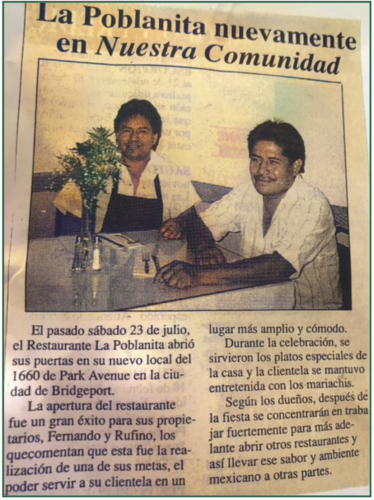
The title in English translates to “La Poblanita Once Again in Our Community”. The article reads:
“This past Saturday, the 23rd of July, the Restaurant La Poblanita opened its doors in its new location on 1660 Park Avenue in the city of Bridgeport.
The opening of the restaurant was a great success for its proprietors, Fernamdo and Rufino, who commented that this was the realization of one of their goals, to be able to serve their clientele in a more ample and comfortable place.
During the celebration, the house specials were served and the clientele were kept entertained with the mariachis.
According to the owners, after the party they will concentrate on working hard to later on open other restaurants and like that bring that Mexican flavor and environment to other places.”
La Poblanita’s Sequal: “La Flor de Mexico Bakery”
La Poblanita Restaurant moved to its present location mentioned above at 1660 Park Ave in July 1994 for more space. In its place, the pair opened a Mexican bakery, La Flor de Mexico Bakery, in La Poblanita’s old location around that year.
Fernando Casiano said, “The next year we saw that it was very small, we moved in where La Poblanita is now… the site that was there before, and still exists today is La Flor de Mexico.” “La Flor de Mexico” is Spanish for “The Flower of Mexico”. “Since we wanted to sell sweet bread, over in Mexico “La Flor” Bakery is very famous where we are from, and so for that reason we… named it that”. When La Flor de Mexico Bakery opened, it started off by selling “groceries and bread”.
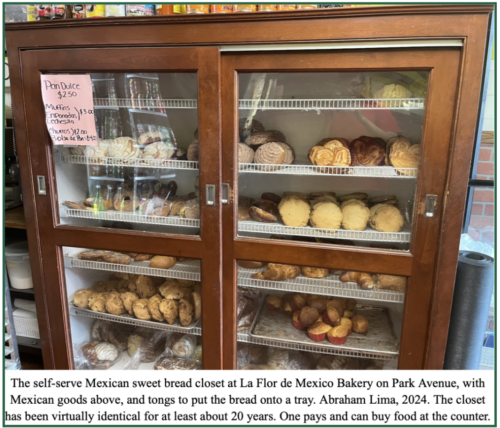
Rufino Flores said “I wanted to make it a bakery even though I didn’t know how to make bread…
Someone from Oaxaca arrived and knew how to make bread. “Don’t worry. You already have your baker. It’s me!”. The first day he made bread, there wasn’t enough. Rufino recalled the baker telling him, “My countrymen are telling me they want bread, but I don’t have any more bread.” Rufino said “Well, make more”. The Oaxacan baker responded “but that will take time”.
One of La Poblanita’s first employees was Teodora “Doris” Ceneno Campes, who was married for a time with one of Casiano’s sons.
“Fernando… and his wife lived in New York. But his nephew, who [today] is in La Flor de Mexico, Mr. Rufino Flores, he was here [Bridgeport], and was a cook in the restaurants here in Fairfield. And there, Señor Fernando and Señora Gloria made tamales in New York, and they would bring to sell in the little Hispanic [Mexican] community that there was here in Bridgeport… and so where the bakery is, La Flor de Mexico, that was the first location they opened. There was Señor Rufino, Señor Fernando, and I think a brother of Señor Rufino which has now passed. There they started making tacos and all that.”
“My name is Teodora Centeno Campes, and I’m from La Trinidad Tepango, Atlixco, Puebla… Ok, my illusions were that several brothers had come here, we are 12 brothers and about 5 brothers had come, and they had not returned, and they promised my mother many things, and they had not returned, and they promised my mother many things. So I came but I did not promise my mother anything…
And that was my dream, to come to work, because in my town there wasn’t a lot of work and we were many siblings, and we lacked many material things, because food and love, no. And I came with the illusion of having a car, [and] a business, which at that time I didn’t have the exact vision of what business I wanted, but I arrived here [to Bridgeport from New York City] to work at a restaurant as a waitress, which still exists, it’s La Poblanita on Park Ave. Then, the owner was Señor Fernando and he had other business partners… and I worked as a waitress and I liked it, then I learned a little in the kitchen.”
On how it was like when she came to Bridgeport, Doris recalled “When I came here to Bridgeport I came alone. I didn’t have a single family member, and I was even scared of walking, before there weren’t Hispanic people like now. From there I began to bring my siblings, almost all of them, she is my sister [points], she has her children, another sister, another brother, and we have already started moving to Bridgeport, and we started moving to Bridgeport.
I came to New York, but I didn’t like New York. So, I was looking for a quieter place, New York is a lot, no, I didn’t like it, so I started bringing my brothers, and they liked it and so that’s why we came. And there are many who are attracted to smaller communities because of the work opportunities.”
Asked if any of the Mexicans worked in Bridgeport factories, Teodora said, “I think the factories, I only heard that there were many factories, but that they had closed, well, for many reasons, and that many Puerto Ricans came, I think with the Italians, and they formed their own gangs and there was a lot of vandalism. At that time when I arrived here in Bridgeport, what is East Main, they had it with cement rods because there was a lot of vandalism, so if they closed the streets with concrete…. There were many that [pause] you had to know well [the neighborhood]because if you went in, there were concrete walls, and you couldn’t get through. That’s all I got there to hear, some things about what there was, a lot of drugs arrived in Bridgeport and that was what finished off the factories that were there. I don’t know if you know East Main, there were a lot of factories there. They say that there was a lot of work, but all that came to an end.”
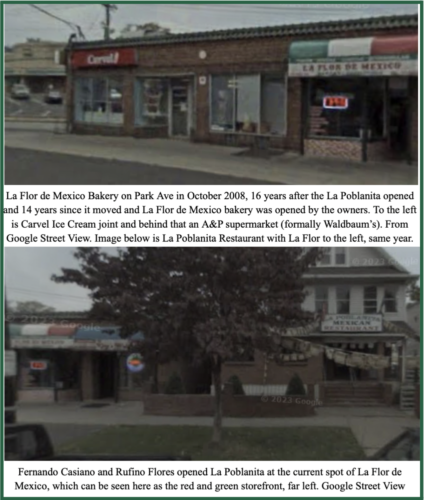
In terms of the city itself, “What was Bridgeport like in those days when you arrived?”
He said, “Well, the truth is, I’m going to tell you, very bad. It was very bad. Because the situation was this, let’s talk about East Main. Drugs hit hard there. So let’s say if this street comes here, they closed it here, they closed it here, and they closed it here. You had to leave where you came in. Because only then, they had to catch them, if they were there to do their purchases or things like that, right? Yes, it was very bad, very bad, before, I heard on that occasion houses that… there were houses for $30,000, $40,000 because the economy was very low here. At that time the factories closed, all the factories there were.”
Rene Vibaldo, born in Bridgeport in 1987 to a family from Tulcingo del Valle, Puebla who settled in the Hollow and later the South End from the Bronx, recalled “Actually Bridgeport was really really bad when I was growing up. You know Father Panik?…yeah I grew up in that generation. Father Panik, the East Side…. [he recalls when East Main St boarded with cement car blockers, an event known as the Phoenix Project to stop narcotics.]
Her mother, Gloria Lucero Huerta recalled at the time “there wasn’t even masa to make tortillas.”. Mexican stores began to open, “The Mexican stores started to open… La Flor [de Mexico], another on Park Avenue [El Mexicanito]… they all started to open at the same time.”
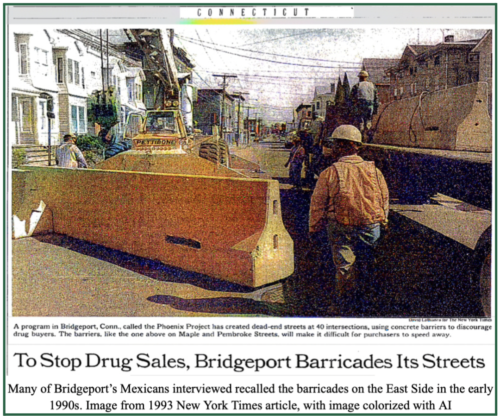
“When I was growing up in the early 1990s when I was 9 or 10”, they lived in the South End “Near Marina Village… we lived on Cottage St, we had a house there”. Growing up “ I had friends at Marina Village, and I’d go over to play… When I was growing up in the early 1990s, One of my best friends I grew up with was Jamaican. There were a lot of Jamaicans… those were some of the people we hung out with… The only Mexican food I had here was what my mom cooked, there weren’t many Mexican restaurants, there weren’t any at first.”
The congregation at “San Pedro”
As mentioned in the last article, Rufino Flores said, “San Pedro [St Peter’s on Colorado Avenue in the West End]. Everyone went to San Pedro. The only one where the priest was a Spaniard”.
Saint Peter’s Roman Catholic church, known in Spanish as “San Pedro”, is located at 695 Colorado Avenue in the West End of Bridgeport, on the intersection with Beechwood Avenue. In 2024, of the 10 mass times a week it offers, 8 are in Spanish and 2 are in English.
Maria Carmona stated her Dominican mother, and her Mexican father, from San Pedro Cholula, Puebla, who settled in Bridgeport in 1954, helped create the Spanish language masses when they saw there were no Spanish language masses in Bridgeport in the mid-1950s.
Asking Casiano “How did the Catholic churches receive the Mexicans who were arriving?”,
“I think it also depends on the priests. When we went there to the church of San Pedro, where Mr. Enavides was, now he has passed away, he welcomed us there. As I said we did big events of the Virgin of Guadalupe, Cinco de Mayo”.
Gregorio from San Bernabe Temoxtitla recalled, “Eh, well, look. When I started going to the church of Saint Peter, we saw about 10 [Mexicans]. Around ’92-’93. But before that, we didn’t know [the congregation at Saint Peter’s]. We started getting to know more.”
A ‘90s City Councilman’s Glimpse into the Mexican Community:
Bill Finch, who was mayor of Bridgeport from 2008-2015, recalled the small Mexican community that existed in the early 1990s. “La Poblanita on Park Ave?… And there was another Mexican restaurant across the street, right? [pause]It wasn’t a restaurant, it was a grocery where they sold stuff from Mexico…. yes, El Mexicano” Finch said
Bill Finch said, “My first recollection of Mexicans in Bridgeport was La Poblanita. At the time I was on the city council.” Someone had told Finch that there was a Mexican restaurant in town. “Mexican? In Bridgeport?” He had never thought of Bridgeport as a place to get Mexican food. “Unfortunately,” he recalled, his palette was not well suited to the spice of Mexican food when he went.
“The Mexicans sort of snuck up on us. Bridgeport is a melting pot, and Mexicans melted in with the other Latinos [laugh]. Because Bridgeport had a large Hispanic community, mostly Caribbean… the white population, the majority of Bridgeport, which they are no longer, assumed that because they all spoke Spanish, they were the same”.
He continued “I know that wars have been fought between these countries… I know Hispanics come in all colors. But the moment they speak Spanish-”, he said, it blurs the line for the non-Latino population between “…Mexicanos, Colombianos, Dominicanos…
Today Bridgeport has Dominicans, Guatemalans, Colombians, Mexicans, Ecuadorians, Peruvians, Hondurans, Salvadorians-”
“El Mexicanito” Grocery and Garibaldi Restaurant: Zaachila on Park Ave
Across the street from La Flor de Mexico and La Poblanita opened El Mexicanito in 1993 by Everaldo Garcia Juarez, who is from Villa de Zaachila, Oaxaca.
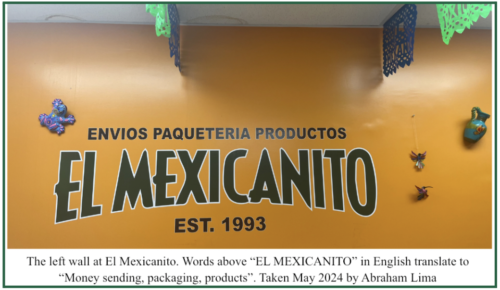
Everaldo Garcia’s son, born in Bridgeport in 1992, said “My parents arrived in 1990 but in Poughkeepsie…he wanted to open a store, but he had friends in Poughkeepsie and didn’t want to compete with them, so he passed by over here and he sold from his car…. he would go to houses to sell, they would tell him “aquí hay paisanos, aquí hay paisanos” [“here are the countrymen”] all the way to Massachusetts” said his son, Omar Garcia.
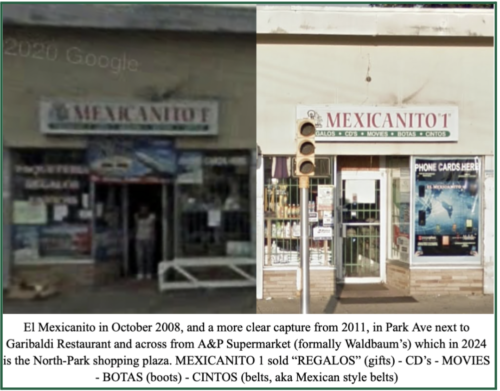
When the store started “It was the 2nd [Mexican] business, the 2nd or 3rd [after La Poblanita and La Flor de Mexico]I think Garibaldi was already there, or it was … or it opened together the same year. The owner of Garibaldi [Alberto Diego] was the one who brought many Zaachilenos to Bridgeport, well he didn’t bring them, but he told them to come.”
El Mexicanito started off selling Mexican goods brought in by Everaldo from Passaic, NJ.
“New Jersey-, Passaic”.
When asked, Evaraldo Garcia said “I came in 1988… I arrived in Poughkeepsie, New York. I arrived here in Bridgeport in ’93…”
Asked “And what brought you to Bridgeport, to the city of Bridgeport?”
“The business brought me to Bridgeport, we were selling [Mexican products] and here we came to sell, house by house”
Asking Everaldo Garcia himself “And when you started the business, why did you start it on this street?”. He said “I started it on this street because it was busier. There was no McDonald’s or anything in front here. There was a store called Waldbaum’s. And that was where most of them came to shop. So there was more traffic of Mexicans in this area. And there was La Flor de México and La Poblanita already [across the street].”
I lived on Maplewood Avenue and Loraine Street… yeah, the Mexican community was down there [Maplewood Ave].
Asked “when you arrived in this city where the majority of Mexicans were from?” He said, “From Puebla and Zaachila, the majority.” And what did they work in, in diners? “In diners”.
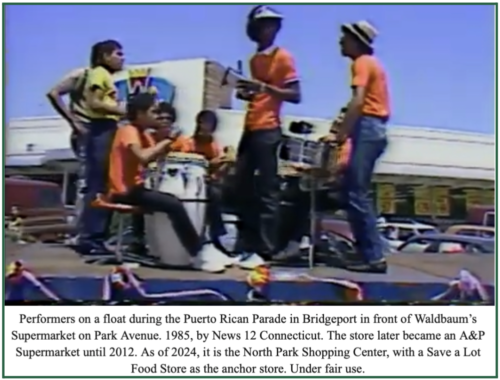
In terms of where Mexicans lived when Garcia arrived in Bridgeport. “Ah, most of them lived, there was a house. 320 Maplewood” which was the first place the first Zaachileños in Bridgeport lived together after living in the diner in Southport where they worked in the 1980s.
What other parts of Bridgeport did Mexicans live in? Garcia said “There was a house near La Poblanita. That one was full. There were [Mexicans] on Howard Avenue [in the West End of Bridgeport], East Main… East Main, almost almost near Boston Avenue… That’s where there were most [in those 3 areas].
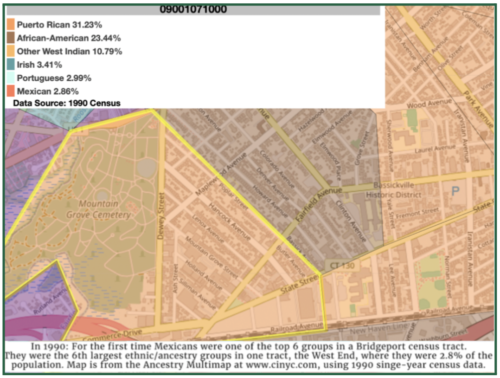
He was related to Alberto Diego of Garibaldi Restaurant. “Here we almost opened the business together at the same time, he also lived in Poughkeepsie… Garibaldi started in 96 around there, 96-95.”
School for Mexican American Bridgeport: early 1990s
Lizzeth Vibaldo remembers “My husband said that when he was in school, he was bullied a lot by the Puerto Ricans because he was Mexican. He got into a lot of trouble because of that. They would call him beaner, he didn’t know what that meant… He went to Bullard Havens”.
Rene Vibaldo, who was born in Park City Hospital in 1987 and whose family, originally from Tulcingo del Valle, Puebla arrived in Bridgeport the year before, recalled that “When I was growing up. It was Blacks and Puerto Ricans. There weren’t even any Brazilians here. I know in elementary school I would get picked on. “
In school, “Like I said it was 4 of us in total, 1 girl and 3 boys. I was the only one in my grade that was Mexican in Roosevelt School”
“Yeah it was like 7th grade “You like tacos, or “You like beans”. It was more the food that we would eat, the mariachi, Speedy Gonzales. Looking back, yeah I like tacos, I like beans, they’re delicious. But I was in middle school then.
The only way I would try to bond was with music. Growing up in my household it was Los Bukis, Luis Miguel. But I would never listen to that in school. I’d listen to Hip hop, I would dress like hip hop you know, with the baggy pants”
Were there Mexicans in other grades?
“I don’t know, that’s a good question”.
In Bullard-Havens Technical High School, one of his friends, Edgar, was also Mexican. Vibaldo’s family said Edgar was from Tecomatlan, Puebla, the municipality between Tulcingo and Piaxtla in the Mixteca Poblana (aka southwestern Puebla). I was like one of 3 [Mexican students] in high school.”
Asked if confused him for Puerto Rican.
“I mean you could tell that I wasn’t Puerto Rican, but they didn’t know.”
Evaraldo Garica’s son, Omar, was born in Bridgeport in 1992 and runs El Mexicanito today. Going to school as a Mexican American “We felt outnumbered, sometimes even made fun of…
I went to Blackham School, Columbus School, and Central High School… in elementary it was probably like 4 [Mexican kids] maybe, middle school was probably a little less, and there were very few of us. High school was maybe 10… kids around that age, you know, “Oh some kid from Mexico”. Even the music, there wasn’t much Mexican music like we hear today, on the streets we hear Mexican music, and before it wasn’t like that, it was mostly rap, reggaeton, and hip hop, and I grew up with that music because that was the only music that was in school.”
I asked, “When you started, were there any other kids on your block?”
Omar replied, “Me and my cousins, from Garibaldi and Guelagetza, we were the only ones.”
Asking Gregorio’s daughter “You said you were younger; did you go to school in Bridgeport?” “I went to Harding,” she said, in the 1990s.
“There were two Mexican kids in Harding, in the whole school, and elementary school, it was just me and my cousin, the only Mexicans in Blackham, and my other cousins went to another school, and they too were the only 2 Mexicans in another school.”
The other Mexican student in Harding, she said, “was from Mexico City”.
Asked if “Being Mexican in school, was it odd or something or did you all just get along?”
Her response was “It was different for us; everyone was Puerto Rican or white and black [laugh]. Uh, we were the outsiders. When I was in school in my class, it was a lot of Puerto Ricans, there was only one Salvadoran, one Dominican, and me, the Mexican.
It was like, everybody knew the Mexican. “You talking about the Mexican? I know her.” Because I was the only one. “You know the Salvadoran?” yeah. It was just like that. Same thing in high school. Then there were 3 of us, and that’s it. You could point, you know, who was not the Puerto Rican. You know like, and were always secluded.
I would get along with Puerto Ricans, but it’s like you know, you don’t speak the same way and certain things. Like they have different traditions, different ways of seeing life, you know? My parents were more strict, they were like free [laugh].”
She said that she still reminisces with her cousin about life back then. “My cousin still remembers “Remember when we were the only Mexican kids in school. We would take the bus, we were the 2 Mexicans, and you couldn’t miss us”. Here on this street [points outside to Fairfield Ave and Alfred St]my little cousins would wait for the bus. And people would say “I saw all these little Mexican kids waiting for the bus” and I’d say “Yes, they’re my cousins. They’re my cousins!”
Everaldo Garcia on the community then:
Asked if any worked in factories, “in fact, I mean, they did start later, like in 95′-96′, to work in factories. In factories – there were many here, but before in those years, as I told you, the 90s were not there, most of them only restaurants, only diners. They hardly worked in other jobs.”
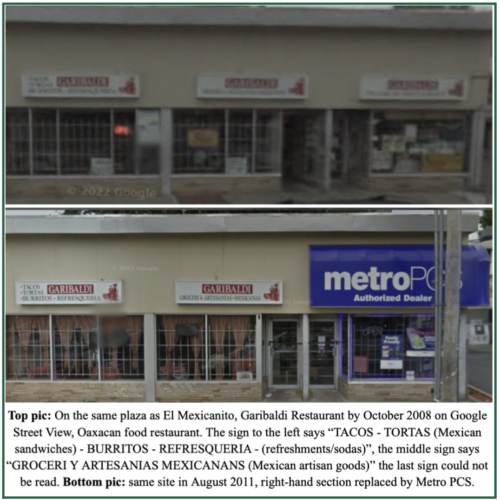
“So, they were only from Zaachila and Puebla in those days?”
Everaldo Garcia said “Most. There were people from Mexico City, there was a small group from Mexico City. We were all very well known [to each other] because most of them came here to sit here on the corner just to talk and that’s why we knew there were people from Mexico City. Mexico City, from Puebla, and from, where is it [pause] Querétaro.” Querétaro is a state north of Michoacán.
Asked if “no other place were the Oaxacans from Zaachila [from], no other places here?”, he said “The majority if you ask, the majority that is from Oaxaca, is from the municipality of Zaachila. There are many, many people”
“Which towns in Puebla did those from Puebla come from?”
“Many people from Atlixco, from Cholula, many, many. Right now here in Bridgeport, there are many people from a town called Santa Clara [Ocoyucan], San Bernabé [Temoxtitla], there are many people from those places.” I asked “And all those people were there from the beginning?”
He said “Some, not many. Like those from Zaachila, it was just a small group.”
Fernando Casiano was asked about people from Queretaro in Bridgeport in those days. He replied, “From Puebla, Tlaxcala, Veracruz, more I do not know.”
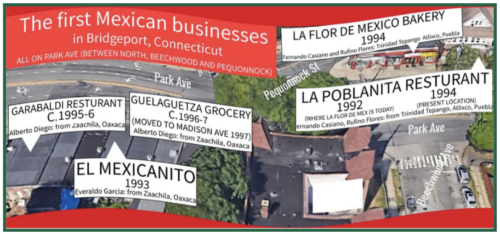
Nick Roussas, the owner of Frankie’s Diner in 2024, said “I’ve heard of Zaachila. The people who worked in this diner were from Oaxaca, Guerrero, and Puebla. Those three states. The guys from Guerrero speak a dialect called- uh- Nakua. Something like that.”
Guerrerenses in Bridgeport:
Fernando Casiano recalls “As I tell you, the community was very small. The most recognized community that was there was from the state of Oaxaca, and later those from Puebla began to come, and like that, it continued. Later came those from Guerrero, yes, because there were already a few, by 94-95 there were by then a lot of people from Guerrero.”
Salvador, a diner cook, who arrived from his town in Guerrero directly to Bridgeport in 2001, explained “Here, all of those who are here from Guerrero, there are many from different towns. There are some, for example, my town is called Alpuyecancingo. There are some from Pochutla, Guerrero… It is close to my town, Pochutla, and one called Zacualpa, almost also attached to the town. There are many of those here too.”
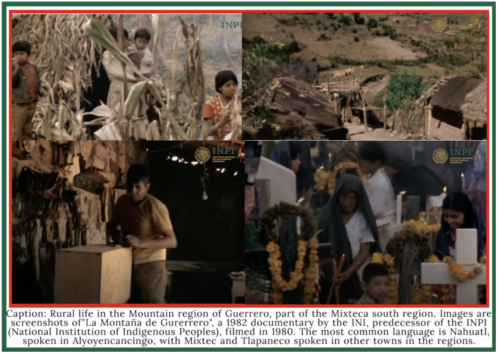
Joining Poblanos from the Mixteca Poblana region of Puebla to New York were people from the bordering Montaña region of the state of Guerrero.
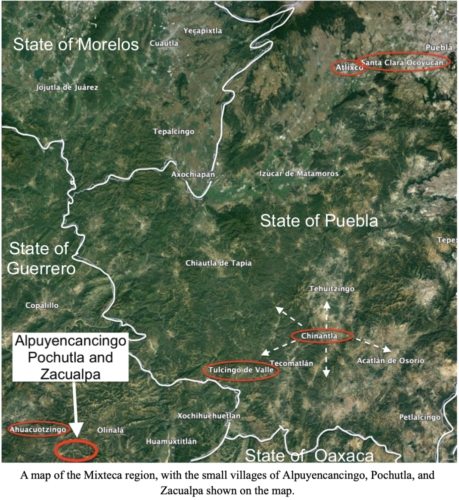
A map of the Mixteca region, with the small villages of Alpuyencancingo, Pochutla, and Zacualpa shown on the map.
The first municipalities in Guerrero to see a mass migration to New York City were Xochihuehuetlan, Huamuxtitlan, Alpoyeca, and Tlapa de Comonfort in the 1980s, connected to the migration chain that brought migrants from next-door Atlixco, Chinantla, Piaxtla, Tecomatlan and Tulcingo in Puebla towards New York City, mostly undocumented/illegally.
The Guerrerenses (a “Guerrerense” is a person from Guerrero) who migrated were originally mostly mestizos (people of mixed European-indigenous ancestry). However, la Montaña is mostly Indigenous; Nahuatl is the main language in the north, Mixtec in the east and south, and Tlapaneco in the center. Later in the 1980s, the indigenous migration from that region to New York began.
Indigenous migrants from Guerrero first began to work as tomato pickers, and also chili and cucumber pickers in northern Mexico by the 1980s, around Culiacán, Sinaloa. They were subsistence farmers, who ate what they grew and traveled north during the crop harvest and returned in the Spring. Previously in the 1960s, the Montana of Guerrero provided the labor for two places, fast-industrializing Mexico City, and the plantations in the nearby state of Morelos.
One young Mexican-American woman, born in Stamford, today a worker at a downtown Bridgeport restaurant, and a Bridgeport resident for five years, said her family was from “Morelos, but my grandparents are from Guerrero… my family settled in Stamford in the 1970s”. Her mother, her mother’s brother, and sister, settled in Stamford to work as teenagers in the early 1990s. Later on, her older brother got a job in Westport, and the siblings moved to Bridgeport. “She follows her brother everywhere, we even live across the street from each other”.
As Guerrenses crossed north into the United States, they went from tomato pickers in Sinaloa to restaurant dishwashers and construction workers. Most of them went to New York City and nearby areas. The migrants from the Mixtec village of Soyatlan settled in both New York City and around Riverhead, Long Island (as agricultural workers), the Nahuatl village of Temalacatzingo split between New York City and Atlantic City, or in this case, those from Alpuyancancingo between New York City and Bridgeport.
When did the migration stream from Alpuyencancingo, Zacualpa, and Pochulta directly to Bridgeport begin?
Salvador said “Well, here, here? Well, here in Bridgeport in the nineties they started arriving… Back then, from the nineties and up. Around ‘92, and ‘94, a lot of them arrived. My uncle arrived in 96. He brought them all from there. In ‘96, there were almost a lot of them. By 2000, the whole town was here [laughs]. Since 2000, they brought women and children. Now there are a bunch of kids here who were born there. There are a lot of them. Here from Alpuyecancingo, there is a bunch of them from Park Avenue, here from Boston Ave, many, many here.”
I arrived [in Bridgeport], I live with some friends from Pochutla and Zacualpa, with those from Zacualpa. There are many of those here. More from Pochutla. From Alpuyecancingo, the whole town is here… almost the majority are here.”
What other places in the United States are people from Alpoyecancingo in?
“In New York, in Washington, and in Virginia.”
When did the people from Guerrero start coming?
“Around the nineties – like the nineties there, yes, like the nineties. Around there, in 2001, almost all of them came here [to Bridgeport]… I came in 2001.
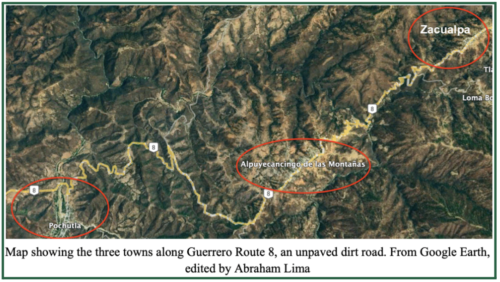
In the 1980 census, Alpuyancancingo had a population of 895 people. Of everyone 15 and older, only 42 in town were able to read and write, and the other 292 were illiterate. 72 children between ages 6-14 attended school.
Nearby Pochutla had a population of 1,049 people, of which 199 of those 15 years and older were literate, and 401 were illiterate.
In Alpucancangino then, not a single household had electricity, running water, television, refrigerators, cars, or telephones, and all had dirt floors, but 79 households had radios.
In Pochutla, of its 194 households in 1980, 2 had running water, 26 had floors other than dirt floors, 133 had radios, 155 had electricity, 11 had refrigerators, 8 had televisions, 4 had cars, and 2 had telephones.
The migration began to Bridgeport because “of necessity, well, I don’t think they come for pleasure [laugh]. You know that in the town there is no money and they come here, well. A dream there, they can’t [not understood]materials. But here, we work and it gets done, but well, with time. Well, you know.”
Bridgeport was the main destination in the United States, “Because the one who arrived first, my uncle, well, was the only one who knew here, and who knows who brought him, I don’t know. But he crossed here and brought all the people, and everyone started to arrive here. Here, everyone came through here, well, I don’t know. And if they liked it, I don’t know. Even I came here! I haven’t left Bridgeport since… My uncle arrived in 94, around there. Around that time. Here, like. Almost the majority is here, I tell you.”
The first language of most of Alupyancancingo’s population is “-Nahuatl. They speak Nahuatl. Everything in Zacualpa is Nahuatl. Except for Pochutla, they don’t speak Nahuatl, only Spanish. You know, only Spanish. But in “Alpoyecan” [short for Alpuyancancingo]and Zacualpa, they speak Nahuatl.”
And do they understand each other? “Yes, of course. in Oaxaca, they also have Nahuatl, in Veracruz they have Nahuatl, it’s the same.”
Of the total population of Alpuyencancingo then, 391 were bilingual in both Spanish and an indigenous language (Nahuatl), and 147 could not speak Spanish, only the indigenous language,
Meanwhile, in the relatively better-off town of Pochutla, the census showed 34 were bilingual in an indigenous language, and only 4 spoke an indigenous language and no Spanish. The rest of the population spoke Spanish only.
Even Antonio from La Trinidad Tepango, Puebla recalled that while growing up in his town, “They spoke to me in Nahuatl. Most of them, most of the older people spoke pure Nahuatl. But now it has changed… in La Trinidad too.”
Salvador continued: The children no longer speak Nahuatl, only Spanish. The little kids. Even the adults spoke Nahuatl since they were older [when they learned Spanish]”.
The first people from Alpuyencancingo to arrive in Bridgeport spoke, “Spanish and Nahuatl because well [they learned]it was difficult.”
Asked if there were issues in terms of of ability to communicate with other Spanish speakers, Salvador said “Maybe, yes. Of course. But what is certain is that we learned when we were older but they didn’t – they didn’t. The little kids [now]already speak Spanish since when they are little.”
The 2014 book “Ayotzinapa. The Journey of the Turtles (Ayotzinapa. La travesía de las tortugas) is the collection of memoirs and lives of the 43 peasant student teachers who went missing by the militants in Iguala, Guerrero, a 2014 Mexican national tragedy.
Benjamin Bautista, 1 of the 43 missing students in that incident, grew up in his town of Alpuyancancwho Benjamin’s father, Miguel Ascencio Tapia, left for the United States and settled in Bridgeport in the mid-1990s. He was followed by his wife and Benjamin’s mother, Cristina Bautista in 1999.
The mother of Benjamin, Cristina Bautista, along with a job at McDonald’s and serving burgers at Burger King, washed dishes in a pizzeria and prepared food at a car wash during her time in Park City after following her husband here in 1999. After the death of her son, she became an activist.
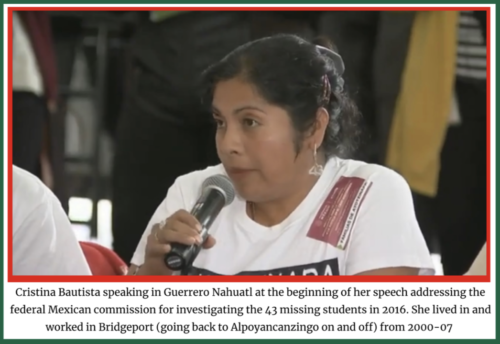
The words “Nextilej noxtimej uan nikan yennemij, tlasokamati ueyi de que nikan yebnualakej, tech kakiskej ken tejuamej tikitoskej nikan” (Guerrero Nahuatl for “Good day to everyone, we greatly thank everyone who came to hear everyone one of us”) were the words she stated before switching to Spanish in her address to the commission appointed to investigate the 43 missing students in 2016, a scene found in the Netflix documentary “Ayotzinanpa, El Paso de la Tortuga”.
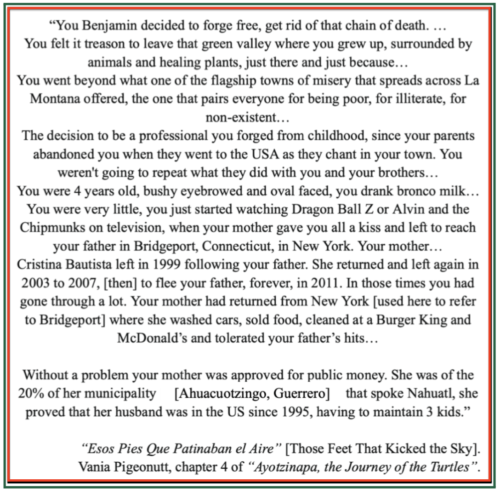
Fernando Casiano speaks Náhuatl “not fluently… it’s what my mom spoke with me” . His former daughter in law and ex-La Poblanita employee, Teodora Campos said “My mom is 83 years old, and she still speaks Nahuatl. But not us anymore, us over in Atlixco, the language they spoke before was Nahuatl, my grandparents spoke Nahuatl. That was the language. But now you hardly hear it anymore, [in the Atlixco Valley] only Spanish.”
In terms of the early 1990s in Bridgeport among the Mexicans “In those days, everyone spoke Spanish, right?”
Fernando Casiano said “Yes”.
“They didn’t use indigenous languages, right?
Casiano responded “I think that yes, yes they spoke in their languages, but very hidden, in their homes, not to the public because you know.”
I interjected “Because of shame?”
He said “Ah, let’s say not shame, but well-“
“It was useless, right? [to communicate]”
He said “Exactly. And there at home, you know, among friends, among family, they may even say something rude in Nahuatl, but there among themselves, right?”
Asked if he understood the Nahuatl spoken by Guerrenses, Casiano said, “Well, it seems like it’s another dialect. They speak it, I know that they speak it. Because a man worked here about 4 years ago and I heard that he spoke to his relative in Nahuatl. But he spoke to him very differently than we do.”
Gregorio’s daughter from San Bernabe Temoxtitla recalled, “My mother speaks Mexican [aka Mexicano, another word for the Nahuatl language, from the word “Mexica”, what the Aztecs called themselves]… She learned it, just by listening to her grandmother. Nobody ever told her, “oh if you know if you wanna learn”, I [her mother] was just listening.”
A man from Alpuyancancingo said he and his wife and their child arrived in Bridgeport in 2010 from their town. The couple speaks Nahuatl as their native language but speak Spanish fluently. Their daughter understands Guerrero Nahuatl but only speaks English and Spanish.
Asked if other people in the Bridgeport area speak Nahuatl, He responded: “Yes, a lot! Almost my entire town is in Bridgeport.”
Asked his town name, he said “Alpuyecancingo… Al-pu-ye-can-cingo”
People from Alpuyencancingo emigrated as “The truth is because there is no work there and because we discovered that more money is made here”.
Asked if those who settled in Bridgeport first from Alpuyencancingo went to New York first, he said “I only know that those from my town here came directly to Bridgeport.” He said, “Those from my town began to arrive in Bridgeport in 1998”.
Nick Roussas recalled that people from Guerrero, “I wanna say they started coming here late 90s, early 2000s.” Nick recalled that at Frianke’s Diner, “We had one or two Mexicans from other states [besides Puebla, Oaxaca, and Guerrero], but they didn’t last because they didn’t fit into the social cliques… Yes, Michoacan was one, and Sinaloa”.
The Mexican-American lady of Morelense and Guerrerense origin mentioned previously said in terms of Mexicans she’s met in Bridgeport,“most of my friends are from Puebla and Jalisco… 2 have families from Jalisco and the rest are from Puebla”.
Tapatio and Tequila: Jalisco and Michoacan
Asking Casiano “How about from Mexico City?”, he responded, “There were already a few…
“And Michoacanos?”
“Michoacanos,- from Jalisco, yes!… From Michoacan and Jalisco, I believe that they arrived, that I knew them, between 92 to 94 they began to arrive, by then a few would go to La Poblanita.”
From the death records found on people from those states in Bridgeport, give examples. Such as in April 1995, the 72-year-old landscaper, Luis Cuevas of Jalisco, remarried a Puerto Rican woman in Bridgeport.
Another example is that by 1997, 21-year-old Salvador Barajas was by then living in apartment #15 at 277 Scofield Ave in Black Rock near the West End. He was born in the municipality of Cotija, Michoacán, just like the butler of New Rochelle’s mayor George Vergara, Antonio Valencia, whose mother’s maiden name was Barajas.
Antonio Valencia began the migration chain to New Rochelle and later Mount Vernon, Mamaroneck, and Port Chester from the area around the municipalities of Quitupan in Jalisco and Cotija and Jiquilpan in Michoacan on the border dividing Jalisco and Michoacán.
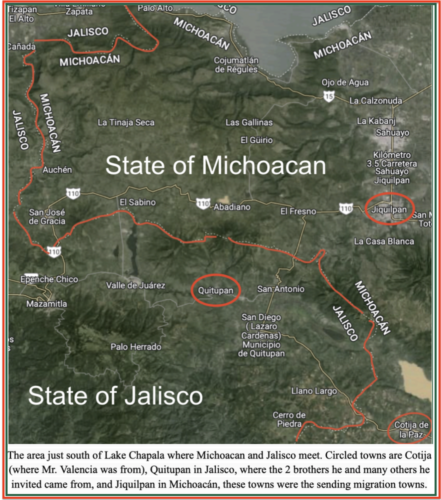
Guelaguetza Grocery:
“Around 1996” or 1997, according records from Buzzfile, and further evidenced by a liquor vending license petition from the grocery to the state in 1999, Guelaguetza Grocery opened on the same store-plaza as El Mexicanito and Garibaldi Restaurant on Park Ave, by the same owner of the next door Garibaldi Restaurant, Alberto (Tito) Diego from Zaachilla. Tito Diego and his wife Luisa soon after moved the grocery to 819 Madison Avenue.
A Jewish and Italian neighborhood for many decades, 819 Madison Ave had been home to a Jewish Kosher deli, Tastee’s Delicatessen, as late as 1977.
Alberto Diego’s son, who was attending the cashier, said that his parents, “they started on Park Avenue and a year later moved here to Madison Avenue.”
“Correct”, said Garcia on where Guelaguetza Grocery started. It was“there where Garibaldi is [today]. There it was. And we were where Metro PCS is.” El Mexicanito moved “because we and Garibaldi shared the rent. So we separated and came here. [to their current location]”
A “guelaguetza”, which in the Zapotec language means “gift, offering or exchange of services’ is a yearly indigenous Oaxacan festival done throughout the towns of the Oaxaca Central Valley.
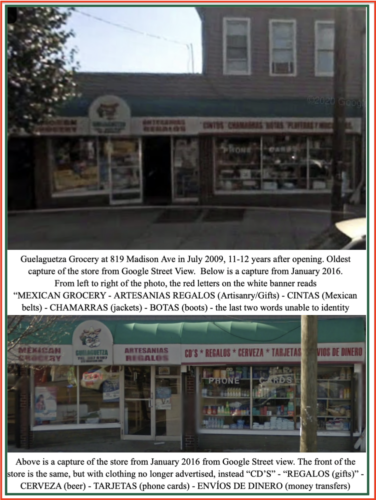
Fernando Casiano later opened a second restaurant, Azteca Restaurant and Bar at Main Street in downtown Bridgeport by 1997 on the site of the former Ocean Sea Grill.
Pizzamen of Puebla and Ovenmen of Oaxaca:
The year after, in 1998, Osesimo Aguilar, also from La Trinidad Tepango in Puebla, registered Two Dollar Pizza House, a New England Greek-style pizzeria and casual Italian eatery on 976 Park Avenue between John Street and Fairfield Ave. It was renamed Five Star Pizza House and Restaurant in 2004.
Gonzalez said the founder of Five Star, “He worked with Greeks, they taught him everything” on the pizzeria trade while working there. The man who started the pizzeria was“Crossroads Pizza. But the owners were different at that time. As I told you, over the years, businesses have changed.” Onesimo Aguillar had lived with the other men from La Trinidad Tepango in Bridgeport in the late 1980s.
When the pizzeria started “It wasn’t Five Star Pizza before, it was called 2 Dollar Pizza. It was called 2-dollar pizza because this little box [grabs a personal pizza box] said “$2” on top. It cost 2 dollars because in those times inflation was less, but now it is no longer two dollars, it is now 6 dollars.”
The co-owner of Julio’s Pizza at 538 Park Ave in the South End, another New England Greek-style pizzeria that opened around 2011, is a Poblano. “I’m from Puebla City.” Asked “Aren’t most here from small towns?” in Bridgeport, he replied “Yes, from Izúcar de Matamoros, Atlixco, around that area. There are a lot of people from Chaulta here. It’s called Chautla- Chautla de Tapia.” Chautla de Tapia is located in the Mixteca region,
Asked what year he arrived in Bridgeport, “Well, I arrived in Hamden… in 1998.”
“There were hardly any, there was only La Poblanita [in Bridgeport]and El Charro Negro in New Haven. For Mexican products, you had to go over to New York.”
Why he settled in Hamden, “I came because I had an acquaintance.”
Most Mexicans, “Here in Bridgeport there are a lot of people from Oaxaca, the majority are from Oaxaca, from what I know.”
From Tlaxcala and New Haven:
“Well right now I know, more more, those that began to arrive were those from Puebla, Oaxaca, Guerrero, and later on the ones from Tlaxcala began to arrive.”
I said, “The people from Tlaxcala said they came to New Haven first”. Casiano responded:
“Yes. There were a few here, a few, but more so they went to New Haven because [here]there were already many Poblanos, many from Oaxaca like they say, we always look where there are a little less people, because the rents where there are already a lot of people, well, you know, the rent goes up more, and well, there were still more opportunities [there], – you paid less rent.”
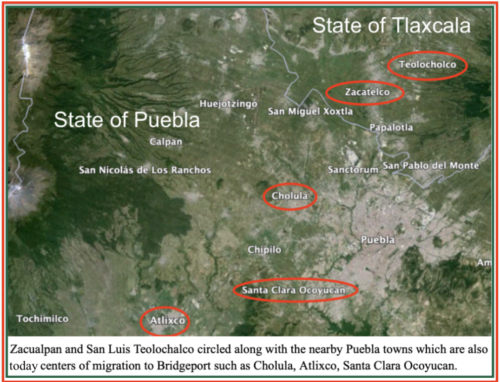
San Bernabe, Santa Martha, and Santa Clara
Omar Gracia from El Mexicanito, which as of 2024 is a package sending store, said “From mostly around in Bridgeport, there’s a whole community of Santa Martha [Hidalgo], Santa Clara [Ocuyocan] and San Bernabe [Temoxtitla]. There’s a lot of people from that area” in Puebla. “It’s like maybe, 30 minutes [from Puebla City]. Santa Marta, Santa Clara, and San Bernabe, they’re all next to each other.”

“Yes, and San Luis [Tehuiloyocan]”, added both Carolina at El Mercadito on Main St in the North End and her niece at La Talavera Grocery in Black Rock.
Carolina and her husband arrived in Bridgeport in 1996 directly from Mexico. Carolina said she was “from near Atlixco” and when asking specifically she said “San Bernabe [Temoxtitla].” Carolina is the aunt of the lady spoken to at La Talavera at the start of this chapter. Carolina and her husband arrived in Bridgeport in 1996 directly from Mexico. “
The first to arrive [from San Bernabé Temoxtitla to Bridgeport] was my brother-in-law in ’92, he came here because his cousins were here, and because here pays better than other states. in any other state you earn more money here. All the states over there are cheap. You don’t make any money. You save more, if you want, if you don’t spend it on clothes… There weren’t many people from either San Bernabe or Mexico.”
Her husband worked ironing clothes “with the Chinese, in Westport.” Meanwhile, Carolina worked “cleaning hotels, in a Ramada hotel, there is no Ramada anymore, but it was a hotel there in Stratford.” She later worked around Main Street in Bridgeport’s North End “in this area, Burger King, I tell you, Marshalls here, Marshalls there, Price Rite here, Price Rite on Boston Avenue, we were over there, working.”
There were no Mexican products… Around, [pause] what year was my son born, [pause] like ’99, 2000, there were no Mexican products here, so I went in my car and went all over Bridgeport, from house to house knocking on doors to see who wanted to buy. There I had chiles, green tomatoes, [and another Mexican product]. I told my brother-in-law and I told him, “you are strong, you sell me these products.” He started selling the products, and then he invented that chorizo, the chorizo that… [sold in the window of the store], cheeses”
“There were, counted, there were about 30 people from San Bernabe” in Bridgeport in 1996, the year she arrived.
“That’s still a lot.” I said. She responded “No! They were few! We all knew each other “this is my uncle, my cousin, my brother, my brother-in-law”. And from there we brought everyone here” to Bridgeport. She made a map with her hands and said “from San Bernabé to Santa Marta, Santa Clara and San Luis… now the whole town is in Bridgeport”.
In a 2012 research paper by Iberoamérica University, professor Elena P. Bilbao González and SUNY-Albany professors Jennifer Burrell and James Collins, recalled that “During the field work, it was found that people from these communities [in Ocoyucan municipality, Puebla]migrate to the northeast coast of the United States, specifically New York City in the case of San Maria Zacatepec, to the area of Lakewood, New Jersey in the case of San Maria Malacatepec and Connecticut for the case of Santa Martha Hidalgo” (“The Mexican Migration and the Access to Health Care Services”, translated from Spanish), with Santa Martha Hidalgo being right between San Bernabe Temoxtitla and Santa Clara Ocoyucan.
Daniel Rodriguez, then a student at Iberoamérica University in Mexico City, wrote a thesis on migration from Santa Martha Hidalgo to Connecticut in his 2008 work “Y Nos Fuimos Pal Norte” (which means “And We Went to the North”). The town in Connecticut is not mentioned.
The man running Tacos Meli, a taco truck on Fairfield Ave and Circular St in Black Rock, is from Santa Martha Hidalgo and came to Bridgeport “in 1998”.
Asked “When you arrived [in Bridgeport] there were already many people from Santa Marta?
He said “No, almost no. I saw that more were coming from other nearby towns. San Bernabé [Temoxtitla], San Gregorio [could be either San Gregorio Atzompa or Zacapechpan], Santa Isabel [Cholula]. Here I saw that there was more from San Bernabe.”
One person from San Gregorio Atzompa was a client at La Flor de Mexico bakery in 2024, on a date with a Salvadoran woman. “I’m from Puebla… San Gregorio Atzompa. My mother is from San Bernabé and my father from San Gregorio Atzompa”
San Luis Tehuiloyucan Tries Connecticut
Don Gregorio explained that, “Since I have a brother-in-law who is from San Luis, I spoke to him and when my brother-in-law arrived here, after a year or two, he helped his brother. From there he brought his family… amongst themselves they helped each other”, starting a migration chain from San Luis Tehuiloyucan directly to Bridgeport.
One man was picking up his kids from a little league soccer game on the North End Library field when asked what year he came to Bridgeport. He replied “I came in 1999… I am from Cholula, 10 minutes from Cholula… San Luis Tehuiloyocan”
Asked if there were many people from San Luis Tehuiloyocan in Bridgeport when he arrived, he said, “No, there were almost none.” Asked if he had family here, he replied “Yes, my brother was already here, he worked in a bakery.”
He explained that. “As he knew about baking, someone told him that there was work here and it paid better than in New York. Because I was in New York first. I went to Bridgeport later because of my brother. “
The bakery was “Portuguese bakery. He had worked in an Italian bakery in New York, so making bread was not difficult for him… [the bakery] was called “Pombal””, located in Bridgeport’s Hollow neighborhood. The reason why people from San Luis Tehuioyucan began to migrate to Bridgeport, he said “maybe because of people they knew”.
A recent graduate at Platt Tech in Milford from Bridgeport, Aca’s family is from San Luis Tehuiloyocan. “For my mom it was 22 years ago [2002] and my dad 26 [1996]. My mom worked at a factory for pasta, you know, food, and my dad works as a landscaper right now. Some of my family was already here [in Bridgeport], that’s why my parents came.”
The Trades Diversify: From Diner Dishwashers to Light Industry Laborers
Everaldo García of Zaachila, Oaxaca recalled that Mexicans began working in non-restaurant jobs in the mid-late 1990s. Included were local factories. “Oh, I can’t remember the names! Since many don’t exist anymore. There was one here on- on the corner of- where Fairfield Ave and I-95 is, there was one where they made pasta. And there was also one where they made screws or something like that.”
The Pratt-Read Tool Company made screwdrivers at 1155 Railroad Ave. (between the railroad and I-95) from the end of the 1900s until 2007. According to the Connecticut Post, the Railroad Avenue factory, in 2004, had 170 employees and made 100,000 screwdrivers daily.
Gregorio, of San Bernabe Temoxtitla, Puebla remembers the pasta factory “You know where it was, they were. Near BJ’s. Well, there was a factory… “
His cousin, whose husband was from a village bordering La Trinidad Tepango, had arrived in the mid-1980s to Bridgeport and had worked in one. “She worked in a factory where they made pasta, cold pasta.” He cannot remember what town that factory was in, but the same company had another company near Black Rock. “There was also another one where Pepe’s Pizza is, on a corner. It was also a pasta factory. There were a lot of people from Mexico there.”
Gregorio recalled “There were a lot of factories. Factories of – Mexicans worked in factories, the ones with the windows, the printing presses.”
Gregorio’s daughter recalled. “Yeah like the window factory. A lot of [Mexican] people… yeah they used to, it was like, everybody was like “Oh I work for the window factory, the window factory.” Same thing with M&T, before when it was People’s Bank… I started seeing a few Mexicans, Puerto Ricans were cleaning, because yeah I did clean those offices and I remember that… I would say yeah like in the 90s. Where the window factory was “I don’t really specifically know because I never really worked there. The only thing I heard was “oh I worked for the window factory” [laugh].
Gregorio said “The one with the windows. That one was on Washington Ave, before reaching Washington Park, 2 blocks before… There were a lot of people working there [from Mexico]. From Puebla. They came from around Puebla [City]… Mexico City around 95’ – 96’.” Which towns? “It was [people from] San Luis, San Gregorio, I think Tonantsintla.”
Gregorio said of the work environment in Bridgeport for Mexican immigrants in the 1990s. “Before there was a lot of work. They walked out of the streets and shouted about work. You could work as anything in those days. There were jobs in restaurants, throwing asphalt. It’s not like now, you have to take better care of your work.”
He recalled they would clean in factories “Well, in the buildings still [before they closed]. Huber, something like that [Hubbell Incorporated. on State St. in the West End]. Oh, cleaning like in 95’-96’, all that”.
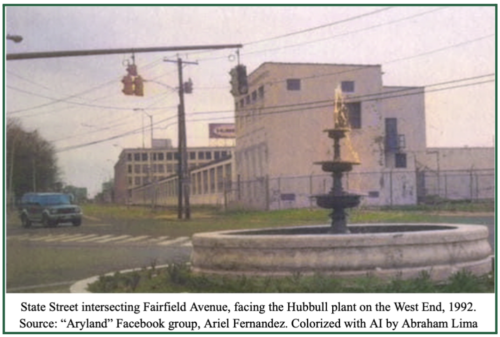
For restaurants, Gregorio remembered, “Well, some worked in Westport, it was called “Sol Y Luna”, there were about 6, 7 [Mexican] people working there.”
Antonio’s wife, Portuguese-American a diner waitress, explained her observations on work life for Mexicans in the 1990s. “I never saw a Mexican who was on the welfare line to ask for help. They worked here where they were wanted. They came with their children and they worked. They were good workers. Not because I’m married to a Mexican, the truth is the truth. Hard workers. They worked 12-13 hours a day. They always come to work.
Listen, they could get drunk the night before, and be here to work the next day! That’s true, the truth is true, and the truth is always true.
I think that the Mexicans, Portuguese, Italians, were the three – I’m sure, other groups more – who came and worked hard. The Portuguese were more into construction. The Italians too. To this day, the Italians and the Portuguese are more constructive. The Mexicans when I came, it was all more restaurants. They started as dishwashers, they went from dishwasher to cook. Some stayed. Others went somewhere else because they were offered something, because they were offered- they were given one or two dollars more.”
Mexican Black Rock:
Asking Teodora Cevantes“Where did most Mexicans live in Bridgeport in the beginning, what part of Bridgeport?”
Teodora replied, “Park Avenue, near where La Poblanita is, the surroundings like on Beechwood, and all over there.” The Connecticut Death Records of the 1990s show most of Bridgeport’s deceased Mexican immigrants listed then resided in the West Side of Bridgeport.
Examples are 32-year-old Gaudencino Flores, with a 2nd-grade education, who lived at 842 Beechwood Ave when he died in late 1997. Another is Laura Campos, a 22-year-old housekeeper with a 12th-grade education, who lived at 916 Norman St when she died in 1998. Rutillo Ibarra, with a 12th grade education, was a 33-year-old chef at a restaurant when he died in June 1999. He lived by then at 619 Iranistan Ave.
Outliers included Gloria Marrero, a 36 year old woman with an 8th grade education. She did not work due to a disability, and lived at 1239 Pembroke St on the East Side of Bridgeport. Vidal Tochimani was a 21 year old who also died in 1999, and he was a dishwasher who lived at 337 Park Avenue in the South End. The last name “Tochimani”, unlike the ones listed, is not a Spanish name, but a Nahuatl one, composed of rabbit (tochtli) + hunter (mani) and means “rabbit hunter”. Most Mexicans with the last name live in Puebla, mainly in Cholula and surrounding areas. Connecticut has the third highest number of the Tochimani last name in the United States, behind Illinois and New York, all of which live in Fairfield County. Fairfield County is just behind Brooklyn (Kings County), Queens County, and 3 counties in Illinois for the entire country.
In terms of Mexican clusters in Bridgeport, Teodora Cevantes continued, saying that “Here on Fairfield Avenue [in Black Rock surrounding Alfred and Princeton St], these buildings, this building that’s here nearby, there were many Mexicans. You’d say almost all from Puebla- Atlixco because I told you the first ones that would arrive, they brought their siblings, cousins, that’s why there’s a big community from Atlixco. Or sometimes between friends, they say “Well, give me a hand”, and then they started coming here like that. And me because I don’t like the city that much, I come from a very quiet town, and well, I didn’t like New York. I told my brothers there was a job opportunity there [in Bridgeport at La Poblanita] and it’s because of the job that I came here, 27-28 years ago.”
Don Gregorio said “Those who were from my town and from the other towns are on this side” in Black Rock, referring to the bordering towns of Santa Martha Hidalgo, San Luis Tehuiloyucan, Santa Clara Ocoyucan, etc.
Asking Gregorio why Mexicans began to settle in Black Rock, he recalled “Because they started to like it. It’s a good area.”
A Mexican recalled a very sensitive reason.“Here [in Black Rock] you hardly see any color, the dark-skinned ones. Because you see, before they assaulted them [the Mexicans], they entered their houses. Before, how they would keep money under their beds…” as illegal/undocumented immigrants could not open bank accounts until later.
Asking Everaldo Garcia “How was social life with other ethnic groups at the time? With Puerto Ricans or African Americans?” He said “At that time it was a problem because there were a lot of Puerto Ricans. The Puerto Ricans abused a lot of our ignorance, I say, of the fear that we as Latinos and immigrants had. We ignored many things, and most of them would assault us, the Puerto Ricans, blacks, and they were directly [towards us]. It was very very difficult, the truth [sigh] at that time”
Asking Fernando Casiano “At that time, how did they get along with Puerto Ricans, Cubans, or other Hispanics?”, he said “Well, look, I had the opportunity to be well received everywhere I went. I’m not going to say, “no, the Puerto Ricans treated me badly.” You know, in any community there is everything, even a Mexican can do bad things, right? Or a Hispanic. But the majority, for me, wherever I go, they recognize me, they know that I have made my contribution.
Before, every December twelfth, [the feast day of Our Lady of Guadalupe, the Roman Catholic patron saint of Mexico] …well so you can see, we did that, we brought mariachis, we celebrated all the holidays. Every September 15th [Mexican Independence Day], we’d bring those who danced, of course in the Mexican tradition, eh? They danced in Jarabe Tapatío. We had teams that – a bus came from Mexico, here, they’d arrived on the twelfth, thirteenth of December, here they were on the fifteenth and sixteenth. So, well I say, we always liked the tradition of our Mexico, and up till now. That’s how it is.”
Bridgeport Mexicans Establish Association:
Rufino Flores recalled he and Fernando Casiano “We prefer to work and not to occupy ourselves” with city program meetings the two were often invited to.
Rosa Correra, a Puerto Rican-born city employee and Hispanic activist who had helped Rufino Flores and Fernando Casiano, continued to encourage the two. Flores said Rosa Correa would say in a serious tone, “Guys, you are missing out on a lot of opportunities. Look at the Puerto Ricans, we have a lot of benefits. You guys don’t have anything.” Mexicans then, Rufino said, “Before, everyone dedicated themselves to work”
Rufino Flores recalled Rosa Correra telling them to go into a room and not come out until they had organized something. “Rosa Correa… She gave us a room in City Hall.”
One city councilman in 2024, Christopher Rosario, born in 1979 and as of 2015 the State Representative of District 128 in Bridgeport, recalled that “My first memory of Mexicans in Bridgeport dates back to the mid to late 1990s. The Puerto Rican community, which I am a part of, did not react negatively to the arrival of Mexicans. Instead, we learned to coexist and appreciate our cultural differences. The Mexican community primarily resided in the Lower Fairfield Avenue of Black Rock and the West Side of Bridgeport. Many Mexicans found work in household services, landscaping, and restaurant services.” He had graduated from Harding High School in the 1990s.
Back in the mid-1990s, Rosa Correra told the uncle-nephew pair, “Whenever you guys want to organize something, we’ll do it, and big!”. Fernando Casiano from there would organize the Mexican Independence Day festivities with traveling Mexican folk groups in Bridgeport for the city’s Mexican community.
Rufino Flores recalled that “The governor of Puebla at the time was such a good guy that he sent a bus with a folk group for free!” He explained later, “At that time the Mexican consulate [in New York City]was close to the governor of Puebla. Once, the governor of Puebla sent the folk musicians directly from Puebla to here… yes, in Bridgeport”.
Yes, because at that time we didn’t know each other. There was Sampablo. He was with the consulate… The one who knew more about the organization is Fernando, he headed that.”
Rufino said “When there would be an Italian event… you would say “I’m from the Association of Mexicans in Bridgeport”
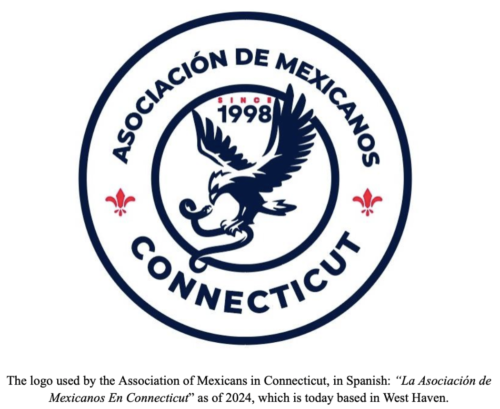
The logo used by the Association of Mexicans in Connecticut, in Spanish: “La Asociación de Mexicanos En Connecticut” as of 2024, which is today based in West Haven.
Refugio Esteban Sampablo Jr explained that “our association, the Association of Mexicans in Connecticut, was founded in 1998. Who were the founders? They were Don Fernando Casiano, Hugo Macuil, Rufino Flores, [Alberto] Diego Mendoza, who was from Oaxaca. All the ones I said before were Poblanos. [And] Refugio Estaban Sampablo Chavez. They were founders in 1998. Fernando Casiano was its president. Then in 2002, Refugio Estaban Sampablo Chavez became the director, and Fernando Casiano no longer directed.”
Alberto (Tito) Diego Mendoza was the owner of Guelaguetza Grocery at 819 Madison Avenue. “Yes, from Guelaguetza- sorry, yes, from Zaachila, Oaxaca. When the association was created, Fernando Casiano owned La Poblanita. Rufino was from La Flor. When my father owned México Magico, México Magico sponsored the organization. He paid the rent. The premises where we had it were lent to the association. The México Magico business opened its doors. México Magico is a multi-service business… [Mexican] passports and consular identification cards.”
He said that the organization got started because “Well, Mr. Refugio Esteban knew Don Fernando. He held the September 15th celebrations at the White Eagle Hall in the city of Bridgeport. … He brought [Mexican] folk ballet to the city of Bridgeport.
Fernando said to Sampablo “Why is it that every time I invite the Mexican consulate, they never come to the festivities in Bridgeport? From there began the association. “We’re going to introduce ourselves to them as the Mexican Association of Connecticut”.
They eventually succeeded. “Those from the consulate would come to give the cry of independence in Bridgeport”.
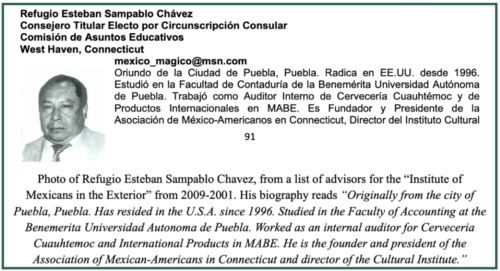
The association was formed so “Well, in 1998, to help Mexicans in Connecticut, so that the Consulate on Wheels would come to Connecticut.”
The “Consulate on Wheels” is a service provided by Mexican consulates in the United States, a form of traveling day consulate set to service Mexican nationals who otherwise might not be able to travel far distances to the consulate of their jurisdiction in major cities. In the case of Bridgeport, that consulate was the Consulate of Mexico in New York, located in Midtown Manhattan. There, Mexican nationals can renew Mexican ID cards, passports, and other services.
“When Fernando Casiano left, I took over. The organization moved to West Haven in 2002. And we have been doing the flag launch in New Haven and the Mexican patriotic holidays. It was founded in West Haven but, for example, we had been working more in Bridgeport. It has always been in West Haven, but when Don Fernando Casiano was president, the meetings were in Bridgeport.”
When Fernando Casiano left, and Refugio Esteban Sampablo took over, the organization moved to West Haven in 2002. The flag-raising has been held in New Haven as well as celebrations of Mexican holidays.”
Sampablo said that in terms of the states where Mexicans migrated from, “Ok. Look, when it [the association] started in 98, the Mexicans arrived first in the city of Bridgeport, it was one of the largest cities with the largest population of Poblanos. There, we moved to the city of New Haven, but the community of Tlaxcala and the community of Michoacán… Bridgeport was Puebla, Guerrero. From there we moved to West Haven: Tlaxcala. In West Haven in New Haven, Tlaxcala, Puebla, Oaxaca, Chiapas. In Bridgeport, it is Oaxaca, Poblanos and Michoacán. A few from Michoacán, but more from Puebla and Oaxaca.”
The towns in Puebla that Poblanos in Bridgeport are largely from, he said “from La Trinidad Tepango, Atlixco, from- uh, what’s it called? Also from the Mixteca Poblana. Look, eh, from Cholula, from San Luis Tehuiloyucan, Tehuacán, the majority are from la Mixteca. And uh, and those from Guerrero, there is a lot from Alpuyencancingo, all that.”
Jason Cruz of Hartford was born in 1996 in Queens, New York and his family is from La Trinidad Tepango.
“Yeah, I mentioned that to my mom and she remembers those folks migrating towards the US when she was in her childhood and when she got older she kept hearing different names here and there of folks from our village going up to New York and then settling throughout Connecticut”.
Jason’s family settled on Lee Avenue in Bridgeport’s West Side and he attended Elias Howe School in 2nd and 3rd grade, after which his family moved to Hartford and settled in Frog Hollow.
Oaxacans in Connecticut come from, according to Sampablo, “Oh, from San Agustín, Huajuapan de Leon, Zaachila, San Pedro…” Large clusters from places like Huajuapan and San Agustín Yanareti are in “other towns where the Mexican population is growing”.
Specifically Bridgeport, however, “from Zaachila, the strongest presence”.
Mexicans Evangelizing Mexicans:
“I’m also from Oaxaca. I’m from a town called Zaachila” said Leobardo, a pastor in Birmingham, Alabama, to a fellow Oaxacan at a Mexican evangelical convention in Tennessee.
“We were the first ones in that church in Bridgeport… brother Edgar [pastor of an evangelical church in Bridgeport] is from the same town as me. He too is from Zaachila. We were school classmates, I would always beat him at marbles! It never passed my mind that he would become a pastor”.
Leobardo (Leo) said “I arrived in Bridgeport in 1994 because of the economy, because the economy was very bad in the country [Mexico]. “
Did anyone invite him to Bridgeport?“no no, I just came over”, as others from Zaachila went to Bridgeport. “Yes, exactly,… it was me, my wife… and we all worked in restaurants”.
Leobardo said he plans to sell homemade tlayudas in Alabama. “God first, that’s the idea.” The Mexican community in Alabama, he said, “they don’t know about tlayudas over there.”
Tlayudas is a dish unique to the State of Oaxaca, made with a large-sized fried tortilla of 20 diameters, fried beans, lard, Oaxacan cheese, and meat.
He tells his wife, “I was saying the thing I miss most about Bridgeport is the food”.
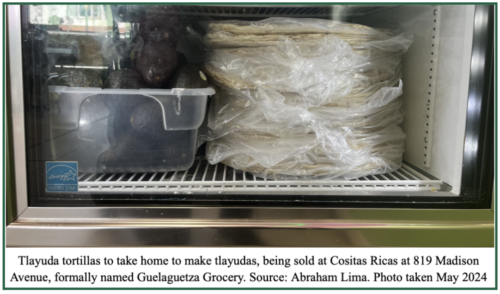
Edgar Ojeda Mendoza joins the conversation and quips “The whole town is in Bridgeport!… Said a man once, “Bridgeport is another Zaachila. Every time I go to Bridgeport I feel like I’ve arrived in Zaachila!”.
Edgar Ojeda said he came to the United States, “For the first time, in 1990. I graduated high school, got my certificate, and came over”, and settled in Los Angeles.
“At the time I came, there was a lot of poverty. That’s why we came. There were no opportunities… a poverty, let’s say, average, because people had something to eat. And the fact that people have something to eat is already a blessing. There was no hunger, but there was suffering… basic things, for example, a bed, a refrigerator, there is no stove, there were few people who had one. They cook with firewood, there is no hot water to bathe like here. Not there.
I arrived in 1996 [to Bridgeport], and I arrived because a friend from Zaachila invited me. I was in California and he told me “Come, there’s work here, come, there’s work here!” and then I started connecting with everyone from Zaachila.” The job was “at Colony Diner in Monroe”.
Mexicans in Bridgeport, he said “Most of them worked in restaurants. At that time, the Brazilians were the ones who had control of construction.”
The restaurants they worked at?
“Almost all of them work in Italian and American restaurants.”
Edgar remembered most Mexicans were“From the states of Oaxaca, Puebla, and Tlaxcala”
And “From other towns they also came, such as from La Trinidad ” aka Trinidad Zaachila, the town right to the south of Villa de Zaachila.
“I also came here because of my countrymen. Those from my town, there are 2, no, 3 places where there are many… from what I know. On Venice Beach in California, in Bridgeport, and here nearby in Poughkeepsie, New York”.
He went on. “Guess who I ran into [in Bridgeport], into brother Hilario!”, Leobardo’s brother, having found him “Ah, with friends we connected with”
He soon found Leobardo and his cousin, Emilio, in Bridgeport. “Because we know each other from Mexico, so that’s why we started to interact with each other.”
After reconnecting in Bridgeport, Edgar shared his evangelical faith with Leo, Emilio, and Hilario, eventually, the three converted from Roman Catholicism. They were the first members of an evangelical Christian congregation in Bridgeport. It was a small mission for a Mexican evangelical denomination named the “Iglesia del Dios Vivo: El Buen Pastor”, which is Spanish for “the Church of the Living God,: The Good Shepherd”.
“The three of us started off… us [Edgar and his wife Alicia], Hilario, Emilio, and Leobardo… It started with the baptism of 5 people… we’d gather in Leo’s house”.
The 5 were Leobardo, his brother, cousin, and their wives, baptized by a visiting minister named Miguel Angel Rios, an immigrant from Tlapehuala, Guerrero and the pastor of a small church in Los Angeles where Edgar Ojeda had converted. Rios himself began that church in his home in Huntington Park, CA in 1985, congregating in his home and later in the homes of a few Mexican families.
Asked where Mexicans were concentrated then, Ojeda said that in his case, “Well, we came to live, do you know where La Flor de Mexico is? There, near Iranistan, on the corner of Iranistan and Maplewood. We lived in Maplewood and we moved to Grand Street, and I don’t remember where, with brother Leo.” Later on, Edgar said “I worked at the McDonald’s on Exit 34.”
Edgar Ojeda recalled that since 1996, “Bridgeport has changed a lot. There were barely any Mexican businesses. We only knew La Flor de Mexico and El Mexicanito”.
In Zaachila, “Very few people still speak Zapotec. The town has already been Hispanicized”
“And In Bridgeport? All Spanish?” I asked
Edgar replied, “Yes, all Spanish, but rude Spanish” [laugh].
By 1999, the small mission had grown, and the congregation rented its first location at 1434 North Ave facing The Hollow neighborhood. The small congregation requested a pastor be sent by the denomination, but none ever arrived. Edgar Ojeda reluctantly became one.
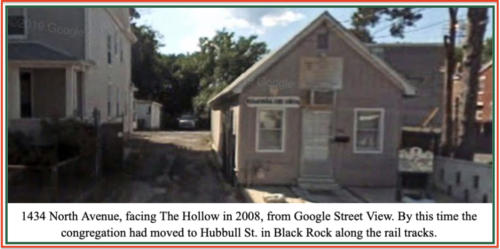
“It was us 3, and then Mario came from Queens [a man from Cuautla in Morelos, see map at the end of this chapter]… then I think came Martín.”
“I am from Mexico City.” Martín Ramirez Rodriguez was born in Mexico City but grew up moving from place to place. Chilmanhuacan, Grajales in central-north Puebla, and his parent’s hometown of Tatoxcac, Zacapoaxtla municipality, Puebla. Both Martin’s parents spoke Nahuatl (their first language) along with Spanish, but Martin and his siblings only learned Spanish.

Location of Zacapoaxtla in the Sierra Norte of Puebla, north of central Puebla and Tlaxcala.
Ramirez landed in New York City because of “friends”, specifically one friend in Mexico City from the same town as Martin’s parents, Tatoxcac, Puebla. Martin arrived at age 20 to Flushing, Queens, where his friend and his relatives from Tatoxcac crammed in an apartment.
According to Maria Isabel Garcia in “La Migración de la Sierra Norte de Puebla a Nueva York”, “in the last five years, those from the Sierra Norte have been incorporated” to the migration chain from regions in Puebla to New York…The choice of this migratory destination was associated with the social networks of the Mixteca Oaxaquena”, which borders the Mixteca Poblana where the migration from Puebla began.
A nearby village, Xonocuautla, already had a soccer team in the New York Mexican League by 1995, playing against teams with names like “Cholula”, “Tulcingo”, “Tlaxcala”, “Guerrero”, “Chinantla”, and other teams named after towns around Puebla and Guerrero. By 1999, the Passaic Herald reported that over 100 people from a town bordering Zacapoaxtla had settled around Passaic, New Jersey.
Martin said, “Since we don’t know the country yet, one does not decide where to go. Usually, a family member or friend goes first, and for reasons unknown to us, they end up in a certain part of the country”.
A cousin of his picked him up from Queens and brought him to attend service in the tiny evangelical church started by the 3 men from Zaachila. His father in Mexico City converted from Roman Catholicism, became a Pentecostal, and in Grajales, Puebla joined a “El Buen Pastor” church. His cousin said, “I told him I had met a few brothers here and if he wanted to go to the service on Sunday”. She picked him up on Saturday and attended Sunday. After service, the men in the tiny congregation encouraged him to stay in Bridgeport.
Martin’s first impression when he settled in Bridgeport was, “You see, I can’t think of anything specific… When you arrive, you think you’re just passing through”.
Martin said of his first job in Bridgeport, “Oh, first I worked for a company that worked for Cablevision. To put all the cable that was underground… So, there was a lot of work”
When he arrived, he lived “With a family in Stillman and Brooks. A family that arrived before me. And I lived there with them for a year.”
Where were the majority of Mexicans from? “Oaxaca, most were from there… And some were from different states. But those others were from everywhere” What other states? “For example, from the State of Mexico, from Puebla, Veracruz… but few.
Those who were where I came to live were from Oaxaca. The majority from Oaxaca were from there… Zaachila. What’s more, the majority of those [the Mexicans] who were here [Bridgeport] were from that town.” Most Mexicans at the time, he said, lived “along North [Ave], where it joins Park Ave, I think…
Yes, I arrived and created an atmosphere in the church. It helped me not to have, so to speak, vices.” When he arrived, the church he attended, there were “about 15”.
Yes, more than anything because of the language. There were very few people who spoke English [among the Mexicans]. For example, going to a restaurant or buying brand-name clothes, was difficult. So, you had to find a restaurant that spoke your language, or a place where Hispanics worked to buy clothes. For example, I didn’t go to eat at Red Lobster, for example, because you didn’t know how to speak English. Over time, you could go eat in those places, either there was a Hispanic working there or you already spoke English.”
What jobs did Mexicans work? “Different jobs. Landscaping, restaurants, drive-thru, cleaner, construction”.
Among the congregants in the small church then was Antonio Montalvo of Mexico City who came in 1999. His first impressions of Bridgeport were “there were hardly any Hispanics, there were Mexicans but not many. There was no Hispanic [Mexican] food. There were many Puerto Ricans, they were the ones who predominated, the Boricuas. Not sure if there still are many.”
Antonio came “because of family. The family arrived first… yes, in Bridgeport. On William Street” on the city’s East Side, where he lived in an apartment together with various relatives. For the church he attended “the church, there was a little church, brother Edgar was the pastor… it was on North Avenue”.
Among the first, he remembered were “brother Abel, brother Martin”. He would later attend the Master’s Seminary, a Reformed seminary. Antonio left Bridgeport and became a pastor in Florida later on, and Martin began a mission in Philadelphia with one family.
Mi Rancho Grocery: the start of the Mexican Black Rock’s Business Cluster
Mi Rancho Grocery and Deli opened in either the year 1999 or 2000, at 2754 Fairfield Avenue in Black Rock, by Rufino Flores and other business partners.

Doris Ceventes recalled that after working in La Poblanita “From there I came [to work at Mi Rancho] here in 2003, they sold a part to me and everyone working [here]. Senor Rufino worked here [in Mi Rancho]… and they called Don Fernando if he could work here, and from there, Don Rufino left and Don Fernando took over, and I was at that time married with a son of Don Fernando and I associated with his wife [Gloria] and I started working here in 2003… He became a citizen here and helped many people get their papers like Don Rufino or those in La Poblanita… he was a cook in New York.
Inside the restaurant section of the small grocery is a mural of Atlixco, Puebla.

In 2024, the Bridgeport History Center chief archivist Elizabeth Van Tuyl recalls when she arrived in Bridgeport in the late 1990s, the Mexican related places in Bridgeport she recalled were “Mi Rancho was the first thing I noticed in my neighborhood. But before, over on Park Ave, I noticed a restaurant, Garibaldi, and across the street I noticed a Mexican bakery [La Flor de Mexico]. Those two things… Then, I started to see more stuff… [laugh]. You know, taquerias, all different things. I would notice things with the Mexican flag.”
Martin Ramirez of Mexico City recalled for grocery shopping “I came in 1999. When I arrived, La Flor de Mexico, Mi Rancho, La Poblanita, the stores on Fairfield Ave [Black Rock], La Guelaguetza, which today is just a changaro [small food stand] were there already.
The Mexicans went to Mi Rancho to buy $100 worth of pantry, instead of Price Rite where it was much cheaper! 100 dollars at Mi Rancho would be $50 at Price Rite! [laugh]… There was a time when they looked at you in certain ways, when you would buy a long-distance phone card or send money, Bridgeport in the 2000s was very racist. Not that it was racist… I wouldn’t use the word racist.”
According to him, the Puerto Ricans not as much “No. Since they all know English, even if it’s a little”
Whenever they went to supermarkets back then, Martin said “the security guards always stared at the Mexicans… It didn’t bother me that he looked at us and questioned us, it only bothered me that he did it because we’re Hispanic”.
In telling Alex Lima
“I only saw La Poblanita, La Flor de Mexico, [pause] and El Rancho.”
One Bridgeport Zaachileno who worked at Athena Diner in Southport was Miguel Angel Hernandez. “You see I was not the first but I was one of them and there were already Mexicans here in Bridgeport. Some of my brothers-in-law were the first to work there and some of my colleagues worked at the Andros Diner, all of them from Zaachila.”
In terms of the Mexicans they found that in Poughkeepsie “almost the majority were from Oaxaca and here in Bridgeport they were already from all over the Mexican Republic and other brothers from other countries!… We (myself) arrived in ‘98 and by then many from Poughkeepsie emigrated to Bridgeport. We stayed in Poughkeepsie for other years and then we migrated here and since then we are here. The countrymen who worked in the diners, many of them started their businesses and companies.”
By 1999, Caroline House, a Roman-Catholic run East Side women education center, taught English and computer use to Mexican women among other groups of immigrant women.
In the 2000 census, Mexicans had surpassed the longer-established Cubans and Colombians as the second largest Hispanic/Latino group in Bridgeport, only behind the Puerto Ricans.
Of all Mexicans in Bridgeport, born abroad or within the United States, 49.3% were immigrants who had arrived between 1990 to March of 2000. In total, 64.8% of Mexicans in Bridgeport were immigrants, compared to 29% being American-born descendants of Mexicans. The 29% born in the US was split between 18.6% born in Connecticut and 10.4% born elsewhere in the United States.


Bibliography:
U.S. Census Bureau (1990). New York General Population Characteristics, 1990 Census of Population
Retrieved from https://usa.ipums.org/usa/resources/voliii/pubdocs/1990/cp1/cp-1-34-1.pdf
U.S. Census Bureau (1990). Connecticut General Population Characteristics, 1990 Census of Population
Retrieved from https://usa.ipums.org/usa/resources/voliii/pubdocs/1990/cp1/cp-1-8.pdf
Pigeonutt, Vania. “Cristina Bautista: 2,555 Días de Dignidad y Amor En Búsqueda.” Amapola, Periodismo Transgresor, 1 Oct. 2021, amapolaperiodismo.com/2021/10/02/cristina-bautista-2-555-dias-de-dignidad-y-amor-en-busqueda/?amp.
Buzzfile Media. “Guelaguepza Grocery.” Buzzfile. Accessed March 2, 2024. https://www.buzzfile.com/business/Guelaguepza-Grocery-203-367-6107
Walsh, Charles. “Deadly Lunch Causes Nutriment Flashbacks.” Guest Columnist, Thoughts From Other Writers. Newark Advocate (OH), August 6, 1994.
Walsh, Charles. “Deadly Lunch Causes Nutriment Flashbacks.” Guest Columnist, Thoughts From Other Writers. Newark Advocate (OH), August 6, 1994.
Buzzfile Media. “MI Rancho Deli Grocery Store.” Buzzfile. Accessed March 2, 2024. https://www.buzzfile.com/business/MI-Rancho-Deli-Grocery-Store-203-696-0201.
State of Connecticut. “Business Records Search.” Business.CT.gov. Accessed March 2, 2024. https://service.ct.gov/business/s/onlinebusinesssearch?language=en_US.
“Expedición de Matrículas Consulares de Alta Seguridad en los Consulados de México en E.E.U.U.”
Expedición de Matrículas Consulares de Alta Seguridad en los Consulados de México en
E.E.U.U. Last modified 2013.
Kugel, Seth. 2004. “URBAN TACTICS; Destination, Neza York.” The New York Times
February 15, 2004. https://www.nytimes.com/2004/02/15/nyregion/urban-tactics-destination-neza-york.html.
X Censo General de Población y Vivienda, 1980. Integración territorial. Estado de Puebla. Tomo 21. N.p.: INEGI, 1990.
X Censo General de Población y Vivienda, 1980. Integración territorial. Estado de Guerrero. Tomo 12. N.p.: INEGI, 1989.
Rodriguez, Daniel. “.Y Nos Fuimos Pal Norte: Migración Internacional, Grupo Doméstico y Remesas Colectivas en Santa Martha Hidalgo, Una Comunidad.” 2008.
Gonzalez, John Moreno. “Long Way from Home: A Pre-Colombian People’s Search for a Better Life Leads to LI.” Newsday, September 5, 1999.
Instituto de Los Mexicanos en El Exterior. “Consejo Consultivo de la IME. 2009-2011.”
Pica, Tom. “Port Chester Aliens Live Lives of Hardship.” *Port Chester Daily News*, January 11, 1974.
Varnon, Rob. “Workers Hope for Aid in Closing.” Stamford Advocate, June 25, 2010. https://www.stamfordadvocate.com/business/article/workers-hope-for-aid-in-closing-537957.php
Hernández Corchado, Rodolfo. “Proletarización y Desposesión de Trabajadores Mixtecos: Orígenes de la Migración Indígena a Nueva York.” 2008.
